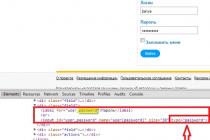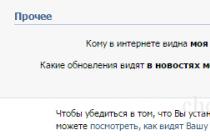So, let us once again designate the direction of this millennial march: Africa - Arabia - Mesopotamia - Iran - Central Asia - southern Siberia - Europe - Black Sea region - Caspian region - Urals. Since then, the R1a group is constantly here! She never went anywhere else. But she remained in the steppes between the Dnieper and the Volga, where she gradually transformed into Russians.
But how was it transformed?
However, one important caveat must be made first.
Note that a haplogroup is not a people!
It is very important to discuss one very important issue at once. In search of our ancestors, we are still operating with the data of a certain genetic identity. Data that a group of people carries a certain trait of their ancestor in their chromosomes. Why, in particular, it becomes clear where the ancestors wandered and lived until they crowned their family tree with the current individual.
But genetic identity is not ethnic identity. Exactly the same as things are with the genealogical trees of, say, Russian noblemen, who branched out, intertwined, sprouted to other countries and peoples - your genealogy is only your genealogy. But not the genealogy of your people. Especially if, for example, as a descendant of Pushkin, you now live in Australia, are a citizen of this country, speak its language and participate in the affairs and life of its people. You, of course, can feel that you are Russian by origin, which you are, but this does not mean that other Australians are the same Russian.
So we cannot say that, for example, the carriers of the haplogroup N are Finns, and the carriers of the haplogroup R1a1 are Russians. No, today both carriers of these genetic markers feel like ethnic Russians. And they are also by nationality, language, history and culture.
And in general, the marker only means that the person's dad inherited it from his dad, he from his, and so on. And only after reaching primitive antiquity, we can note that the first father of one came from other places than the first father of the other.
No, when I say in this book that the speakers of R1a1 are Russians, then this is just a fraction of the conventionality necessary for a coherent presentation. Moreover, the share is quite large. In the end, there are a lot of representatives of this haplogroup among the Poles, many among the Kirghiz, many among the Indians, it is generously scattered throughout Europe. But the Kirghiz does not become Russian just because they both once had a common ancestor. With a certain amount of poetry, they can be called blood relatives, but they are not one people and cannot become.
It is another matter that when large numbers appear - say, the same 47% of R1a1 carriers in the Russian people - due to simple respect for science, statistics, it remains to assume that such a multitude of related men once formed one community.
This community could also be - and certainly were! - representatives of various haplogroups. Genetics had not yet been invented, there were no corresponding scientists with thin analyzing instruments. They distinguished their own from someone else's primarily on the basis of language. And having already decided on this, they calculated the ancestors and dealt with kinship.
Therefore, for ancient times, the rule is very important: those who spoke the same language most often formed a more or less numerous kindred group. Which can, with a certain degree of convention, be defined as a tribe or people. But as soon as a group was divided and its parts lost their linguistic connection, they certainly became different peoples. While remaining representatives of one genetic haplogroup.
And in the same way, tribes that converged for one reason or another together soon became one people, despite different genetic markers.
It is in this contradictory reality that we will track the further path of our ancestors.
Linguistics provides very important data. And in particular, with the help of its methods, scientists reconstruct the languages that have gone along with the disappeared peoples, trying to get to the first proto-language spoken by the first people.
The language of those first people is a complex problem and it seems insoluble. This single proto-language, perhaps, did not exist at all. Especially if we accept the hypothesis that the language of humanity originated in several centers at once. And most likely, it was so: different primitive herds and tribes passed from monkey sounds to words in different places and in different natural conditions. Therefore, the designations for objects had to be different. Of course, our legendary first "Adam" made some sounds. How similar they were to speech, to language - for the times when he lived, the question is open. But his offspring began to diverge so radically and over such huge distances that, of course, in the new place of deployment, the conceptual apparatus had to be invented virtually anew.
So there might not have been a single language of primitive humanity at all. And there was, according to the hypothesis proposed by the Russian ethnographer S. P. Tolstov, a kind of "primitive linguistic continuity." In his opinion, at the dawn of history, humanity spoke numerous languages, which gradually passed one into another in the adjacent territories of contact between tribes and constituted as a whole, as it were, a single continuous network ("linguistic continuity"). Accordingly, S.P. Tolstov believes, -
- language families could take shape in the process of gradual concentration of individual languages of small groups, their contraction into larger groups that inhabited significant areas of the globe.
It is believed that the formation of language families should have begun about 15 thousand years ago, at the end of the Paleolithic. That is, this is an indirect confirmation of the above hypothesis - by this period the offspring of “primitive Adam” had definitely dispersed across the planet in such a way that they could not maintain contact with each other. Except in some cases of neighborhood.
Whether this is so or not, and whether S.P. Tolstov is right, it is difficult for me personally to judge. Linguists argue among themselves no less bitterly than historians. Therefore, I will cite a more traditional point of view, according to which languages arose in the course of the disintegration of some proto-languages common to all mankind.
Then in Asia Minor, in particular, the so-called "Nostratic group" of languages was formed. And about 13 thousand years ago, this family began to disintegrate, apparently, settling in Eurasia. In the process of linguistic divergence accompanying that resettlement, the current main groups of languages were formed: Indo-European, Semitic-Hamitic, Uralic, Altai, Kartvelian, Dravidian.
Please note again: the fact that the "Nostratik" began to settle in Eurasia does not mean that it was empty and that it was inhabited by people from Western Asia. As we know, quite energetic groups of hunters lived and hunted mammoths and horses along the tundra-steppe near the spurs of the glacier. They belonged to the Willendorf-Kostenko culture and, above all, were very inventive and art-loving gentlemen. It is they who own the famous "Paleolithic Venuses" - female figurines of a rather erotic look.
Resident of the settlement of Kostenki. Reconstruction by M.M. Gerasimov
Perhaps the carriers of Nostratic languages became the founders of several huge linguistic families because the same law that we just spoke about was in effect on them: one community was torn apart - a linguistic divergence started; met and united with another community - language convergence began. And at the end - today - we note common features between the Eskimo and Russian languages, although in no way, either genetically or archeologically, these peoples had nothing in common.
That is why today the “Nostratik” is credited with various archaeological cultures - Svider, Arensburg, post-Svider microlithic-macrolithic traditions, and so on. Dealing with this is not the task of this work, and it is unlikely that at all, without possessing a time machine, it is possible to reliably compare archaeological signs with the speakers of any languages. At least for that era.
But one thing can be stated with certainty - whoever genetically Nostratikos are, in the future Russian Eurasia they encountered carriers of the haplogroup R1a.
It is known that our closest relatives and Indo-European languages are native speakers of the Eastern Nostratics, which gave the Uralic, Altai and Dravidian languages.
But what's interesting:
- R1a among the southern Dravidians (and in tribal groups and in the lower castes, which, in general, excludes mixing with the Aryans) is as ancient as the European one.
And thus it can -
- to indicate that the R1a markers were in the hands of the Pratostratians, and with their dispersal they spread throughout Eurasia.
And if we assume that modern researchers of gene genealogy are somewhat mistaken with the timing of mutations? Perhaps the mutations were not at all as regular as they think! And they keep counting for generations. But now generations are separated by 20–25 years, when people have their first child. And before that they were in a hurry to live, for a few years were then measured for people - 25–30. By forty - already an old man ... This means that they had children as soon as they could do it physically - from the age of 11-12. And if this difference is taken into account, then we have a rather curious coincidence of the data of genetics with the data of linguistics.
Pranostratikas existed in linguistic and ethnic affinity in Mesopotamia and Iran. Yes, but the same thing happens with "us" with the period between the M89 and M9 mutations!
There, the Semitic-Hamites (haplogroup J), carriers of non-Indo-European Caucasian languages (haplogroup G), carriers of non-Indo-European European languages (haplogroup I) separated from "us".
And "we" - those who did not stay where they were - are gradually shifting to India. From where "our" already Nostratic community goes to the north, to Central Asia. There, its final disintegration takes place.
There "we" get the M45 mutation. It is possible that this is somehow connected with the disintegration of the community. A certain natural cataclysm, a cosmic phenomenon, a change in the Earth's magnetic field - but you never know! L. Gumilev, for all the ambiguity of the attitude to his theory in the academic world, was not in vain forced to assume the influence of external, almost cosmic influences on the development of peoples. Otherwise, these mysterious explosions of their activity or passionarity are inexplicable. And here - here it is, a mutation! Sits on the Y chromosome, broadcasting something extraordinary that then affected large groups of people. Something was affecting a numerically significant group of males. Because of what, perhaps, they were separated from the former community, in which those who were not affected by that impact remained.
By the way, such an assumption - the bias of the genetic data in time - allows us to solve the problem with "Adam" and his belonging to the Neanderthals or Cro-Magnons. In this case, our first ancestor turns out to be quite Cro-Magnon!
It is interesting that a similar, but without any consideration of genohistory, idea was expressed by the famous American linguist-"Nostratologist" A. R. Bomhard: first, the separation of the Semitic-Hamitic proto-language, then the Dravidian, then the Kartvelian, and then the division of what remains.
Not being a linguist, I do not presume to comment on this, but in any case, such a closeness of the pictures obtained through the vizier of different sciences is remarkable.
In a word, it probably happened that during that disintegration - or rupture - in Central Asia, carriers of both "Finnish", "East Asian", "Siberian" and even "Indian" haplogroups, as well as future Uralic ones, dispersed in different directions. Kartvelian, Dravidian and other languages of the Nostratic group.
It remains to add: and Indo-European, but ...
The fact is that, judging by the data of linguistics, the Indo-Europeans began their historical path not with us at all! Not with R1 marker carriers!
In any case, the widespread settlement of the Indo-Europeans was, in principle, possible only -
-… in a very narrow period of time - during the period of the last cold snap - the Younger Dryas - during which the overwhelming part of Northern Eurasia became unpopulated, the main population concentrated in very limited areas, in our case in Asia Minor and adjacent areas. Then they settled very widely, creating a network of weakly interacting closely related dialects ...
This resettlement is confirmed by many facts, including genetic ones. But! This automatically means that our ancestors, carriers of haplogroup R1a, were not ... Indo-Europeans! Despite the fact that we, their descendants, speak one of the dialects of the Indo-European language. Paradox?
The thing is that the Indo-Europeans began to break up into different communities much later than that very young Dryas, which happened about 13 thousand years ago, when “our” haplogroup began to disperse along the ecumene. And they began to disintegrate not from the area where we mark not even R1a or R1b, but at least just R1 ...
In general, there is no consensus even about the original place of origin of the Indo-Europeans. Someone points to Western Asia - Mesopotamia, the Armenian Highlands. Someone - on the steppes of the Northern Black Sea region. Someone refers to the proto-Indo-Europeans those first hunters who followed the beast to the north as the last glacier retreated - the fruit of the Wyrm-Valdai glacial. And therefore their homeland is vast areas in the steppes of the south of Eastern Europe, the Urals, Siberia, and Central Asia. Someone is talking about the Balkans.
One of the most interesting theories about the appearance and migration of Indo-Europeans was put forward by well-known experts on this topic, Academician of the Russian Academy of Sciences V.V. Ivanov and his colleague T.V. Gamkrelidze.
Based on the oldest evidence of the Hittite and other Anatolian languages, these scientists attribute the allocation -
- Anatolian community from the Indo-European proto-language and thus the beginning of the disintegration of the proto-language by the period no later than the IV millennium BC. e., and possibly much earlier.
Moreover, this separation took place precisely in Asia Minor, as evidenced by toponymic - more precisely, hydronymic - data, as well as the concepts of the reconstructed common language... Based on the study of this reconstructed vocabulary, one can, as it were, "see" what the ancient Indo-Europeans saw and accordingly called -
- the first thing that can be asserted with sufficient confidence about the Indo-European ancestral home is that it was an area with a mountainous landscape. This is evidenced primarily by the multiplicity of Indo-European words denoting high mountains and hills.<…>Such a picture of the Proto-Indo-European landscape naturally excludes those flat areas of Europe where significant mountain ranges are absent, that is, the northern part of Central Eurasia and the whole of Eastern Europe, including the Northern Black Sea region.<…>Paleobotanical terms also indicate the correlation of the Indo-European ecological environment with the Mediterranean zone ... The ancient names of trees, consistent with the characteristics of the mountain landscape of the Indo-European ancestral homeland, localize it in the comparatively more southern regions of the Mediterranean in a broad sense, including the Balkans and the northern part of the Middle East (Asia Minor, mountainous regions Upper Mesopotamia and adjacent areas).<…>This localization is consistent with the so-called "beech argument", which excludes from the ancestral home a part of Eastern Europe northeast of the Black Sea region to the lower Volga (where beech is absent throughout the post-glacial period), but compatible with its localization from the Balkans to the Middle East.
Arguments up to migration:
Assuming the territory of the Indo-European ancestral home, spatially coinciding with the area within Eastern Anatolia, the South Caucasus and Northern Mesopotamia V-IV millennium BC. e., one can more easily explain the historical distribution and migration routes of such main ancient Indo-European ethnic groups, which are the first to appear in ancient written monuments - Hittite-Luwians, Indo-Iranians, Greeks (Crete-Mycenaean Greeks and Ahhiyava, Hittite sources). In order to determine the ways of their resettlement to historical places of residence, it is not necessary in this case to assume that they have covered huge distances, moving from the area of their initial settlement. It is sufficient to allow only small displacements in relation to this area. It is noteworthy that these dialects, which imply a minimum displacement relative to a given area, are the oldest documented Indo-European languages.
According to current views, the disintegration of the Indo-European language was -
- a multi-act process stretching for millennia. At the first stage, the Anatolians, then the Indo-Aryans, Iranians, Armenians, Greeks, Thracians and Tochars, separated and began to develop as distinctive ethno-linguistic formations.
And, according to Academician Ivanov, the Anatolian dialect group was really the first to split off. She moved westward relatively short distance... Having settled in a new place, people - carriers of this dialect later appear in history as Hittites.
Then the Greco-Armenian-Aryan dialect community separated from the common Indo-European language system, which later split into Greek, Armenian and Indo-Iranian dialects. Already from this community, the Aryan dialect stood out. The "Greco-Armenians" remained in place for some time, but then the speakers of the Greek dialects began to shift towards the Aegean Sea. Apparently, the speakers of the Phrygian and Balkan dialects also shifted along with them.
Unfortunately, the migration process of the Indo-Iranian or Aryan dialect group is not very clear. In any case, it appears in Central Asia. And from there -
- apparently, in the form of repeated migration waves directed from east to west of Eurasia, where later these tribes settled and settled in a certain common territory, -
And Indo-European "European" languages arose. Including Slavic ones.
But how and why these migration waves arose is not entirely clear.
Of course, we will never get an exact answer to this question - without the same notorious time machine. However, here other sciences come to our aid - climatology, geology, archeology.
Note in parentheses that according to the data of palynology - a science that studies pollen and plant spores preserved in soils, in particular in its cultural layers, during the Holocene, that is, the current geological era, which began about 10-11 thousand years ago and in which we now we live, - several global phases of warming and cooling have changed. And there were still a lot of waves of migration of the ancient population, in particular, “ours”, spreading in different directions. And they are inexplicable, if you do not take into account climatic and - more broadly - natural phenomena.
And now, if this circumstance is taken into account, then the reason for the Indo-European migration becomes approximately clear. Apparently, this was the case.
While there was a glacier in Eurasia, the Central Russian and Black Sea tundra steppe was, with all the abundance of mammoths and woolly rhinos, a zone of extreme climate and risky food. But when it was warm 11-12 thousand years ago, and the glacier retreated, and then about 7 thousand years ago, the warmest and wettest period in the Holocene began, when -
- the average July temperature at latitude 50 ° was 1 ° C higher than the present, at latitude 60 ° - 2 ° C higher and north of latitude 65 ° - 3–4 ° C higher -
Here, in the center of Eurasia, living conditions became very favorable.
Warmer than now -
- winter temperatures were 2 ° C higher in almost all of Europe -
The climate allowed the forests to move far to the north. Mammoths, however, were extinct by that time. But at the same time, it became warm and humid in the steppes, and herds of animals from the south rose on the sweet grass.
You can imagine what it looked like from the stories of millions of herds of bison in North America. There are not too many Indians, and they are very busy exterminating each other. The beast is killed practically only for the sake of food (sometimes for the sake of valiant prowess). And the number of this animal is regulated only by the amount of edible grass and grizzly bears. Which, to be honest, also prefer smaller prey.
In general, it was here that heaven on earth was opened for our ancestors. Where are they - this is already archeology asserts - and were primarily engaged in cattle breeding. Moreover, it is here, as it is assumed, that our ancestors tamed the horse for the first time in history. During the times of Sredniy Stog culture.
It is to these people, to these cultures that the Indo-Europeans came.
What drove them north?
The then version of global warming.
Under its influence, the water level of the World Ocean increased. And one day, about 6 thousand years ago, the Bosphorus opened. And the waters of the Mediterranean Sea fell into the future Pontus of Euxine. Geologists say water flooded the shores at a rate of one kilometer a day! In less than a year, the sea level has risen by tens of meters! More than 60 thousand square meters were flooded. km of land, i.e. about 30% of the current area of the Black Sea. In fact, it was a flood.
So there are grounds for the statements of the most serious scientists that the legend of the Flood itself was born among the Indo-Europeans who lived in the Black Sea basin and survived this catastrophe.
Actually, it has long been proven that the text about the flood came to the Bible from Sumerian myths:
... The extermination of my people ...
I created the goddess Ninthu ...
Indeed, I will return it to her.
I will bring the people back to their places of residence.
May their cities be built, may their troubles be dispelled.
Bricks in all their cities to sacred places
Verily, let them deliver.
Let them be gathered in holy places.
Holiness of water - fire extinguishing - let it be
Established in righteousness.
Rituals, mighty Essences will truly be perfect,
Let water irrigate the earth, I will give them a blissful peace.
<…>
All evil storms, all hurricanes, they all came together.
The flood is raging over the whole world.
Seven days. Seven nights.
When the flood raged over the country,
A spiteful wind in a high wave
Tossed a huge ship
The sun rose, lit heaven and earth,
Ziusudra made a hole in his huge ship,
And the sunbeam penetrated the huge ship.
King Ziusudra
Fell down before the sun-Utu.
The king slaughtered the bulls, slaughtered many sheep.
In the context of searching for our ancestors, a few lines earlier are interesting:
When An, Enlil, Enki, Ninhursag
They created a black-headed people,
The living creatures in the ground began to multiply violently,
All kinds of four-legged creatures
the valleys were covered with a pattern worthy ...
Pastoralists, not otherwise. Which, of course, the farmers and builders of the Mesopotamia canals were not.
In addition, the later Babylonian version was inserted as a story in the epic about Gilgamesh "About everything that has seen ...". And Gilgamesh is a very real ruler-lugal of the first dynasty of Uruk in Sumer (approximately XXVII – XXVI centuries BC). And in the "Nippur royal list" it is said about him:
Gilgamesh, whose father was a nomad ...
The latter, of course, is rather circumstantial evidence. But against the general background ...
In a word, you will run away from such a cataclysm. And in Mesopotamia, and the Balkan Mountains, and the Armenian Highlands. Just about - to the very Mount Ararat! Like Noah at the head of his menagerie. And from Mount Ararat, the fragments of the Indo-Europeans affected by the catastrophe should have gone beyond the Caucasus Mountains. And disperse around the Caspian.
Sumerian tablet with a record of the legend of the flood
By the way, the linguistic data of the so-called glottochronological analysis determine that the disintegration of Indo-European linguistic unity has occurred - for sure! - just in the IV (according to the average estimate) millennium BC.
Looking a little ahead, we can talk about the second stage of the separation of languages and, therefore, Indo-European peoples:
As a result of many years of linguistic research, the German Scientist G. Krae came to the following conclusion: while Anatolian, Indo-Iranian, Armenian and Greek languages have already separated from the rest of Indo-European and developed as independent, Italic, Celtic, Germanic, Illyrian, Slavic and Baltic languages still did not exist. The dialects on the basis of which these languages developed were then a fairly homogeneous community and were related to each other to varying degrees.
This ethno-linguistic community existed in Central Europe in the 2nd millennium BC. NS. and was named by G. Krae ancient European. Over time, the Celts, Italians, Illyrians, Veneti, Germans, Balts and Slavs emerged from it. Ancient Europeans developed common terminology in the fields of agriculture, social relations and religion. The traces of their settlement were specific hydronyms, characterized by the same researcher. He determined that the areas of Central Europe north of the Alps were the earliest region of settlement of the ancient Europeans.
At the same time, contacts between those who left and those who remained were preserved and maintained at a fairly close level:
The famous Soviet Iranianist V. I. Abaev identified a number of North Iranian-European linguistic rapprochements and parallels in the field of mythology, indisputably testifying to the contacts of the ancient Iranians of Southeastern Europe with the not yet dismembered European tribes ... crafts O. N. Trubachev came to the conclusion that the carriers of the early Slavic dialects or their ancestors at the time when this craft terminology was formed, were in close contact with the future Germans and Italians, that is, the Indo-Europeans of Central Europe. The scientist defines the Central European cultural and historical area, which in general corresponds to the archaeological area - the territory of the Central European community of burial urn fields and the hydronymic core of the ancient Europeans.
The Indo-Europeans, according to the famous researcher Beshem, who carefully analyzed the Vedic epic of these tribes, looked like this:
... they were tall, fairly fair-skinned people, most of them long-headed. They tamed the horses and harnessed them to light carriages on three wheels with spokes ... These people were mainly engaged in cattle breeding and a little farming.<…>Either because of overcrowding, or because of the drought that hit the pastures, or for both of these reasons, these peoples began to move. They migrated in groups in the western, southern and eastern directions, conquered local peoples and mingled with them, forming the ruling elite. They brought with them the patrilineal system of kinship ... the ability to use horse chariots ...
True, the "Vedas" - four collections of sacred chants and ritual rules "Rigveda", "Yajurveda", "Samaveda" and "Atharvaveda" - belong to the later, Aryan culture. More precisely, they have come down to us within the framework of this culture. But some scholars attribute the date of creation of the "Rig Veda" even to 6000 BC. NS. It is difficult to believe in this, but many agree that, in any case, these hymns-songs-rules-knowledge already existed at the time of the beginning of the exodus of the Indo-Europeans from their ancestral home. That is, in the era of the Black Sea spill, at least.
And here is what information genealogical genetics gives on this topic.
True, before that it is necessary to make a reservation: the Indo-Europeans, or Proto-Indo-Europeans, are a kind of philological abstraction. This is someone who was a native speaker of a language reconstructed by linguists. And this term has nothing to do with haplogroups and haplotypes. In the same way, we repeat, as today the speakers of at least three large haplogroups speak Russian.
Indo-Europeans, according to geneticists, are carriers of at least a dozen haplogroups! In this respect, this language family is very similar to the Altaic family, in the languages of which genetically heterogeneous ethnic groups also communicate.
Therefore, the researchers make a logical conclusion:
These ten haplogroups could not leave one narrow area, moreover, only 12-15 thousand years ago (when most of these snips were obtained, and, therefore, these haplogroups were already formed).
Indeed, they could not. For, as we know, the Proto-Indo-European language was formed only 6-7 thousand years ago! When carriers of R1 genetics have long lived in Northern Eurasia ...
And really -
- most of the Armenians inherit the Y chromosome of haplogroup J2 - the Middle Eastern group with a common ancestor age of 6200 years.
The Armenians, as we already know, are part of the Proto-Indo-Europeans.
And the Greeks who left the Armenians?
And the Greeks, who left the Armenians, retained the same haplogroup J2, which is still the most common in this ethnic group today - 25%. Moreover, using the specific marker J2f1, scientists today are restoring the directions and ways of ancient Greek colonization. In addition, the increased frequency of distribution of J2 and another "Greek" haplogroup, E3b (20%), in Sicily and Cyprus, serves as an indirect evidence of the same phenomenon. With Cyprus, everything is clear - a Greek island where even Aphrodite was born. And Sicily at the time of Ona was Greece even stronger than Greece itself. And even so it was called - Greece Magna, that is, Great. And Syracuse exceeded the population of Athens and was the largest Greek city.
The Hittites have a similar picture: in the territory where they lived, the J2a * -M410 group also prevails. At the same time, there is also one indirect, but very interesting proof that it was this group that belonged to the Hittites.
There is very convincing historical evidence that the legendary Etruscans, in fact, who gave the cultural impetus to ancient Roman civilization, originated from Asia Minor. The legends that they were the descendants of the Trojans who survived and fled from the Greeks of Menelaus can be left as legends, but archeology clearly speaks of the relationship between the Etruscans and Asia Minor cultures. And Troy, whoever Achilles and Odysseus fought against from an ethnic point of view, was a Hittite city or part of the Hittite sphere of influence.
Recent publications indicate that haplogroup J * (xJ2) is found with an increased frequency in Italy in Central Tuscany - that is, in the historical homeland of the Etruscans. And thus genetics confirms archeology, and together they once again say that the initial Indo-Europeans were carriers of the haplogroup J *.
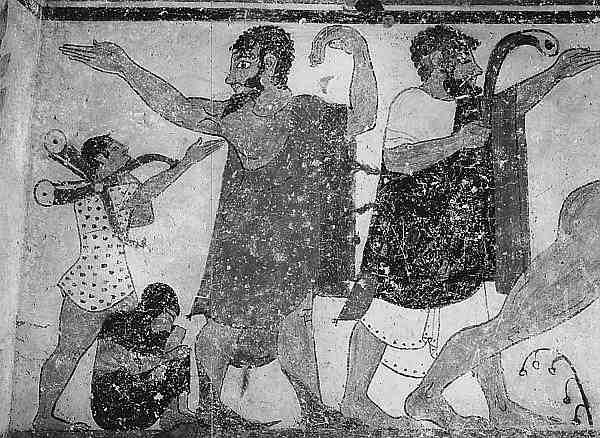
Detail of an Etruscan fresco
In this regard, the origin of this haplogroup is curious.
The latest genetics suggests that the Proto-Indo-Europeans are indeed the offspring of Asia Minor. And those who are considered Indo-Europeans today - carriers of the R1 group markers - are genetically very, very far from the original linguistic Indo-Europeans ... Just as the Semitic-Hamitic languages are far from the Indo-European ones.
Thus, we are convinced again: the Indo-Europeans are not the ones who set off on a further campaign with the future Papuans. This is the part of the "Nostratikos" that remained in place in Western Asia.
By the way, the already familiar carriers of haplogroup I1b - "Balkans", the genetic component of the Russian people - also turn out to be not Indo-Europeans!
The fact is that in the V millennium BC. NS. it is here, in the Balkans, that the oldest center of civilization in Europe arose. Wherein -
- the culture of the ancient Balkans of the 5th and 4th millennia BC NS. characterized by developed agriculture and the use of cereals of ancient Middle Eastern origin, copper metallurgy, which was also formed under the likely influence of Asia Minor, the presence of a rather complex religion and corresponding symbolism, including pictographic signs of a linear nature.
On these grounds, this culture is brought closer to an even more ancient civilization in the west of Asia Minor - Chatal-Guyuk (VI millennium BC). Archaeologists and linguists find it difficult to determine the ethnic character of both these civilizations, but from the genetic point of view, it is possible that these were people of haplogroup I1b ...
So, "we", carriers of R1a1, are not like Slavs! Not even Indo-Europeans! It turns out that just the Indo-Europeans are newcomers to "our" territory! They - one of the groups or several groups - migrated here, to the post-Nostratic hunters. Where, according to genetics, they were assimilated so that they did not even leave their own male chromosome line in the offspring. But they left the language.
And here a contradiction arises. It is believed that in a patriarchal society, languages should be inherited patrilineally, that is, along the male line. Which automatically means - together with the Y-haplogroup. However, in the history of the Indo-Europeans, we see something else: the local population inherited the language of the newcomers, but their genetics, it turns out, did not. Therefore, we should talk about matrilineal translation, about the transmission of language through the maternal line. How can it be?
The first thing that comes to mind is Indo-European mothers. It was they who turned out to be the keepers of their language, since they were the first to put it into the minds of children. We will see the same process more than once in history. For example, when the Sarmatian people appeared. There are more modern examples - for example, the matrilineal formation of the Farsi language after the actual destruction by the Arabs of the Pahlavi, the former literary language of Persia during the Sassanids (III-VII centuries). And in general, all the former written Persian culture.
And who said that the society of those poststratic hunters was patriarchal? And not, say, was in some form of matriarchy? That the latter - or its remnants - can take on very bizarre forms can be seen even today. For example, from the customs and mentality of the Ethiopian Mursi tribe. He wrote, however, like an eyewitness, so I don't know how much truth there is. But what I had to read - and partly collide myself - in ethnography, speaks for the fact that nothing is impossible in what is described below:
They are considered the most aggressive ethnic group. All men walk around with Kalashnikovs, which are illegally handed over to them across the border ... Those warriors of the tribe who did not get the guns, or who simply left them in their homes, carry sticks with them. With these sticks, they prove their leadership. Anyone who claims it must beat their competitors to a pulp.
However, the high military and leadership qualities of men does not mean, as will be seen from what follows, that their own women cannot control their lives. And even more so - priestesses.
According to the traditions of this mystical tribe, all of its women are Priestesses of Death. In the evenings in their hut, they first prepare some relatively light narcotic potion, grinding the dried fruits of a special marsh nut into powder. Pouring it on a plate-dabi inserted into her lip, each woman brings the narcotic food closer to her husband's lips, and they both begin to lick it off at the same time. This part of the ritual ceremony is called the "kiss of death" ...
Then a bunch of ... intoxicating grass is thrown into the smoldering hearth, which begins to emit upward streams of yellowish smoke. The man climbs on the rails of the "mezzanine" and lies down over the hearth in such a way that the trickles of the sweet incense rises directly to his face. He does not lie down just like that, but placing his head on the groove of a special stand-pillow. About two dozen of these amazing sleeping devices are kept in the hut of the High Priestess of the tribe, called srek. ... While the man is dreaming sweetly in the smoke of the dope, the wife is preparing to give him poison ... After some time, the Mursi woman rises to her sleeping husband and blows into his mouth a deadly powder from her lip plate. This part of the mystical rite is called "death bite" ...
Having poisoned their husbands, all the Priestesses of Death gather in the srek hut and perform some kind of mysterious ritual there. The sinister ritual ends with an action that ... the Mursi call the "gift of death." The High Priestess goes around all the huts of the village, going up to the poisoned men, and puts a saving antidote in their mouths, portions of which are in her necklace, which adorns her complex "hairdo". And no one, except for her and the God of Death Yamda, whose will was carried out by the High Priestess, does not know: all the men of the tribe are ordered to live on, or not all. There were times when Srek did not give an antidote to one of them. Then, leaving the hut, she draws a white cross on his wife's lip plate. Such a woman remained a widow for the rest of her life and had great respect in the tribe, like a priestess who fulfilled her duty to the almighty Yamda.
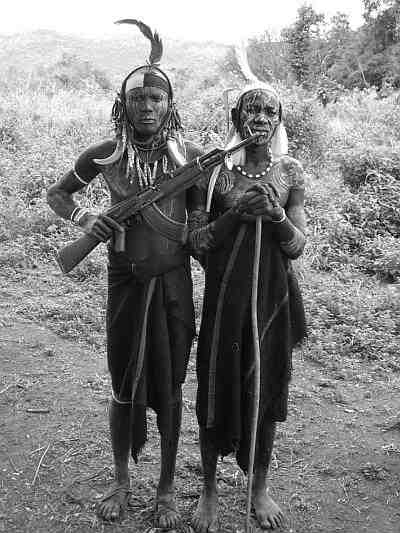
Men from the Mursi tribe (Ethiopia)
Another option is also possible. Opposite. For example, the more advanced Indo-European aliens defeated the steppe carriers of the R1a marker. And they became the ruling elite in the synthetic tribe formed in this way. Even though it was relatively small in number, it “forced” all this new tribe to speak its own language. And there are such examples in history - the Aryans with their conquest of India or the Ottoman Turks who conquered Byzantium.
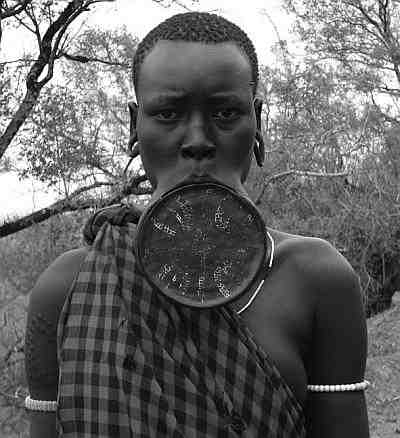
Mursi woman (Ethiopia)
True, there are other examples here too - when the elite who have seized power adopt the language of the vanquished. These are the Scandinavian-speaking Normans in French Normandy. And they, already "French" - in the German-speaking England conquered by William. It is, finally, we, the Russians, in whose history the Scandinavian-speaking Rus, three or four generations later, spoke Slavic. So the migrating Proto-Indo-Europeans, having headed the locals, adopted their language, and then, obviously, due to their small number, genetically dissolved in them ...
With a certain degree of confidence, we can calculate the region where this “melting” of aliens and locals took place into a single ethnos, where the former brought their language, and the latter, genetics.
As genetic studies show, -
- the greatest variability of the R1a marker is found in Eastern Ukraine, which may indicate the greatest antiquity of its distribution in this region.
Here, the division of the R1a carriers into subgroups-proto-tribes took place, which later became peoples:
... the Black Sea steppes served as the dividing point. Here the R1a1 group split from the R1a group. R1a went west, part of R1a1 went south either through the Caucasus or to Central Asia and further to India (Indo-Aryans). Undoubtedly, a little later, those who went to the West again (the Scythians, followed by the Sarmatians), partly to Southern Siberia (Dinlins), split off from the Central Asian group.
This very impressively agrees with the place in the theory of V. Ivanov (more precisely, the theory of Ivanov - Gamkrelidze), where it is stated -
- the newly arrived tribes joined those already settled on this territory, and thus a common intermediate area was formed for the Indo-European tribes migrating from the east, who later settled in the more western regions of Europe. Thus, this common intermediate area becomes an area of contacts and secondary convergence of Indo-European dialects, which had already partially drifted from each other, where such lexical and semantic innovations could arise. ... The spread of dialects from this common "secondary area" - in a sense, the "secondary intermediate ancestral home" of the tribes who spoke the corresponding dialects - to new territories in Central and Western Europe laid the foundation for the gradual emergence of separate languages (Italic, Celtic, Illyrian, Germanic, Baltic , Slavic), conventionally referred to as the territory occupied by them in the historical era, "ancient European". Thus, for the "ancient European" languages, the general initial distribution area (albeit secondary) can be considered the region of the Northern Black Sea region and the Volga steppes. The theory that localizes the “ancestral home of the Indo-Europeans” in this area takes on a new meaning in this light as a hypothesis about the ancestral home for the western group of Indo-European languages. This temporary area of joint habitation of tribes - carriers of ancient Indo-European dialects could serve as an area where various migration waves of carriers of these dialects moved and secondary isoglossies were formed, superimposed on the old ...
... The supposed intermediate area of settlement of the carriers of Indo-European dialects in this sense can be considered as in a certain sense their "secondary" ancestral home, that is, the territory of their joint habitation for a certain time, before the start of a new period of migrations further to the west.
Thus, the correlation between the data of linguistics and genetics turns out to be very close. At the same time, what is important, similar conclusions were reached by specialists in their own science, who do not really trust the data of another. In any case, the identification of Indo-Europeans and carriers of R1a is today the mainstream in genealogical genetics. And most of the geneticists, whose data I refer to, are inclined to consider the ancestral home of the Indo-Europeans precisely Tavria and the Volga region. Despite the fact that, as we can see, even their own data speaks of a significant time gap between the formation of the haplogroup and the formation of the Indo-Europeans themselves.
In addition, toponymy also provides certain data for additional localization of the area where the "r-one-ts" met with the Indo-Europeans and adopted their language:
Traces of the stay of carriers of "ancient European" dialects on the territory of the "secondary ancestral home" can also be seen in the specific nature of the hydronyms of the Northern Black Sea region, which, minus later layers (in particular, Slavic and Iranian, compare names such as Don, Dnieper, etc.) Indo-European hydronyms, which are attested in Central European hydronyms. These hydronyms include hydronyms, which show similarities in suffixes and stems with "ancient European" ones, which in itself should reflect their common Indo-European character. It is characteristic that the ancient Indo-European hydronyms are preserved behind small rivers and tributaries of large rivers, while the large rivers themselves are renamed when new ethnic groups appear.
Archeology provides similar information.
In the V-IV millennia BC. NS. people of the so-called Dnieper-Donetsk archaeological culture lived in the Steppe. Judging by the materials of the excavations, its creators were engaged in hunting and fishing, but along with this they quite skillfully made ceramic dishes, grew cultivated plants and grazed, as already mentioned, cattle and small ruminants.
And next to the Dnieper-Donetsk culture, the Sredniy Stog culture began to develop, which also "sat" in the steppes between the Dnieper and Don. These people were also not savages - a developed, judging by the burials, a religious cult, quite civilized tools. Even making toys and figurines wasted time and effort.
Two cultures in one place are already forcing archaeologists to conclude that from the very beginning in our steppes there was no single, including Indo-European, community. And there were various associations of Neolithic hunters and pastoralists, to which the Indo-Europeans could join.
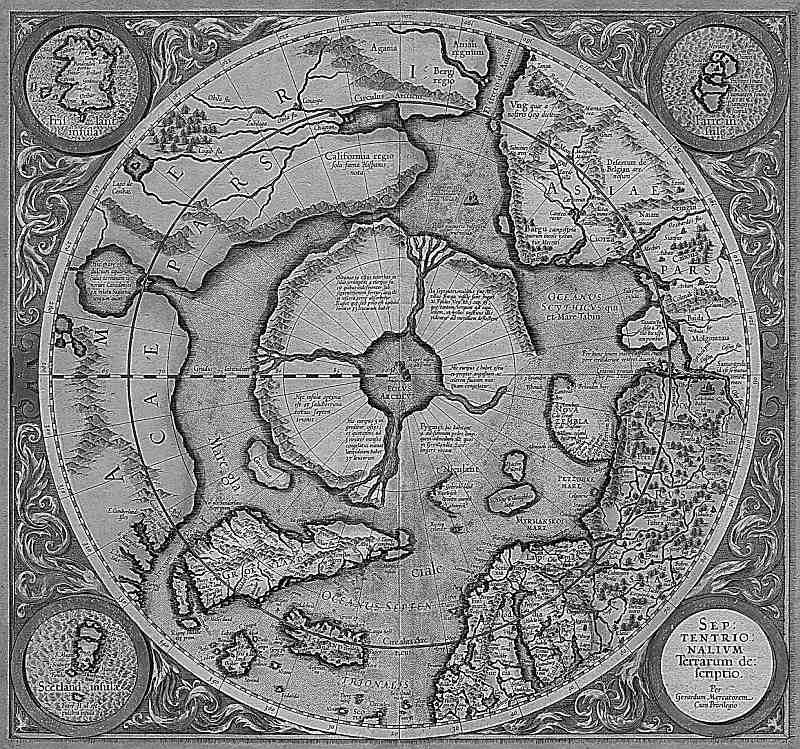
Hyperborea on the map
Mercator. XVI century
So, the data are combined and paint a completely logical picture for us: some of the speakers of Indo-European dialects, which shifted to the north through the Caucasus and Central Asia, met in the local steppes with the local autochthonous hunting and cattle breeding population. For certain reasons - first of all, apparently, because of the proximity of the surviving Nostratic dialects with their hereditary Indo-European ones - the aborigines adopted the language of either conquerors or assimilated refugees. A community was formed, which gradually began to be joined by aliens from different places. But such additions naturally created heterogeneities. Therefore, from this heterogeneity, from this "melting pot", certain communities were regularly separated. And they left - some to the west, some to the east, some to the south.
Where they carried stories about the country, where it is good. And they gave rise to the myth of the blessed Hyperborea.
SO:
X-III millennium BC NS. Russian carriers of the R1a gene marker are not biologically Indo-Europeans. They completely assimilated one of the groups of Indo-Europeans, while adopting its language, which, like their own, had roots in the same Nostratic language family. Thus, Russians, like the European carriers of the haplogroup R, are Indo-Europeans only linguistically. Approximately in the V-III millennia BC. NS. the place of formation of European "linguistic Indo-Europeans" was the space of southern Russia from the Northern Black Sea region to the Southern Urals. Perhaps it is said about him in various ancient legends about "blessed Hyperborea" (see Fig. 12).
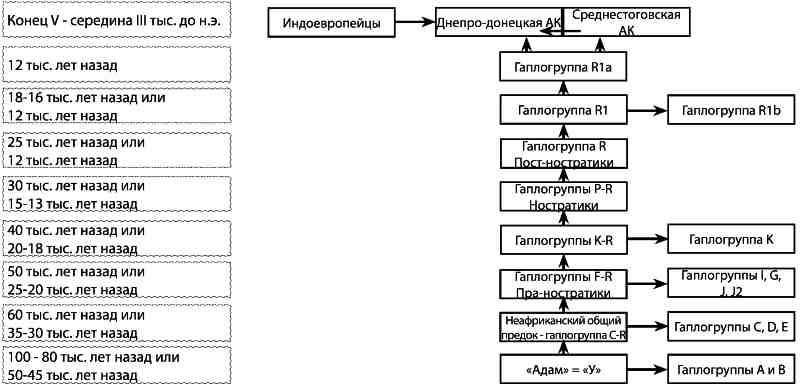
Rice. 12. Family tree
The main occupation of the Indo-Europeans was arable farming. The land was cultivated with the help of harness arable implements (Rala, plows). At the same time, they apparently knew gardening. Cattle breeding occupied a significant place in the economy of the Indo-European tribes. Livestock was used as the main pulling force. Animal husbandry provided the Indo-Europeans with food - milk, meat, as well as raw materials - leather, hides, wool, etc.
At the turn of the IV-III millennium BC. the life of the Indo-European tribes began to transform. Global climatic changes began: the temperature dropped, the continentality increased - hotter than before, summer months alternated with more and more severe winters. As a result, grain yields have declined, agriculture has ceased to provide guaranteed means to ensure the lives of people in the winter months, as well as additional feed for animals. The role of cattle breeding has gradually increased. The increase in herds associated with these processes required the expansion of pastures and the search for new territories where both people and animals could feed. The gaze of the Indo-Europeans turned to the endless steppes of Eurasia. The period of development of neighboring lands has come.
From the beginning of the 3rd millennium BC. the discovery and colonization of new territories (which was often accompanied by clashes with the indigenous population) became the norm of life for the Indo-European tribes. This, in particular, is reflected in the myths, tales and legends of Indo-European peoples - Iranians, ancient Indians, ancient Greeks. The migration of tribes, which formerly constituted the Proto-Indo-European community, acquired a special scale with the invention of wheeled transport, as well as the domestication and use of horses for riding. This allowed pastoralists to move from a sedentary lifestyle to a nomadic or semi-nomadic one. The consequence of the change in the economic and cultural structure was the disintegration of the Indo-European community into independent ethnic groups.
So, adaptation to the changed natural and climatic conditions forced the Proto-Greeks, Luwians, Hittites, Indo-Iranians, Indo-Aryans and other tribal associations formed within the framework of the Proto-Indo-European tribes, to go in search of new, more economically suitable territories. And the continuing fragmentation of ethnic associations led to the colonization of new lands. These processes occupied the entire 3rd millennium BC Abaev V.I. Scytho-European isoglosses. - M .: Nauka, 1965, p. 127.
> Indo-European problem
The term "Indo-European languages" was introduced into scientific circulation at the beginning of the 19th century by the founder of comparative-historical linguistics Fr. Bopp. Later, German scientists began to use in the same sense the term "Indo-Germanic languages", as well as the terms "Aryan languages" (A.A. Potebni) and "Ario-European languages" (I.A. Baudouin de Courtenay, V.A. Bogorodnitsky). Today the term "Aryan" is used in relation to Indo-Iranian languages, and the term "Ario-European" has fallen out of scientific use. The term Indo-Germanic languages continues to be used as well. Despite the fact that neither the time and ways of settling the Indo-European proto-tribes nor the place of their original residence remain unknown, researchers adhering to the Indo-European theory attribute the following groups of languages to this language family:
· Indian group. Ancient Indian, which is the language of the Vedic texts. Although the Vedic texts are not dated, the period of their origin is usually attributed to the 2nd millennium BC. The oldest dated texts date back to the 3rd century BC. and belong to the period and place of reign of King Ashoka, i.e. geographically it is the southern and eastern parts of India. At the same time, according to some ideas, the initial settlement of the ancient Aryans on the territory of India took place in the northern and western parts of it. Those who hold the opinion about the deep antiquity of the Vedas are inclined to explain such a discrepancy in dating by the Brahminist tradition of their oral transmission that existed for a long time. Oral transmission of the Vedas was carried out in order to protect their content from the eyes of the "low-born" (representatives of non-Aryan varnas). Sanskrit is a literary and normalized form of Old Indian. There are chronological and dialectal differences between the Vedic language and Sanskrit, i.e. these languages go back to different dialects of ancient Indian speech. Modern languages attributed to the Indian group - Hindi, Bengali, Urya, Gujarati, Punjabi, Sindhi, Marathi, Sinhalese, etc. Abaev V.I. Scytho-European isoglosses. - M .: Nauka, 1965, p. 150
· Iranian group. In the early era, it was represented by the ancient Persian (VI-V centuries BC, cuneiform inscriptions of the Achaemenid kings) and, again, not precisely dated, but considered even more ancient, Avestan. This group, on the basis of several surviving words and proper names (gravestone inscriptions), includes the language of the Scythians of the northern Black Sea region. Old Persian was replaced by the so-called languages of the Middle Iranian period (from the 3rd century BC to the 7th-13th centuries AD) - Middle Persian, Parthian, Sogdian, Khorezm and Saka, mainly belonging to the peoples of Central Asia. The new Iranian languages include Tajik, New Persian, Kurdish, Baluch, Talysh, Tat, Pashto and some Pamir languages - Yagnob, Shugnan, Rushan, etc. In the Caucasus, the Iranian group includes Ossetian.
· Tocharian language. General designation of two mysterious languages - Turfan and Kugan, texts in which were found at the beginning of the XX century in Xinjiang. Despite the fact that these languages do not belong to any of the known groups, they were included in the number of Indo-European.
· Slavic group. Old Slavic is best recorded in the monuments of Old Slavonic or "Church Slavonic". The translation of the Gospel and other liturgical texts, made by Cyril and Methodius in the 9th century, was based on the South Slavic dialect of the city of Solun (Macedonia). It is believed, however, that this dialect was understood by all Slavic tribes of that time, since the Old Slavic did not have serious differences. Concerning the ancient Slavic A. Meie, affirming its archaism and closeness to the most ancient Indo-European, indicates the absence in it of a large number of such forms that can be identified with the common Indo-European. Modern Slavic languages include Russian, Belarusian, Ukrainian (eastern group), Bulgarian, Macedonian, Serbo-Croatian, Slovin (southern group), Czech, Slovak, Polish, Kashubian, Lusatian (western group). The western group also includes the extinct language, Germanized in the 18th century, Polabian Slavs who lived along the lower reaches of the Elbe (Laba) River.
· Baltic group. Includes modern Lithuanian and Latvian languages. The oldest found monuments date back to the 16th century A.D.
· German group. The oldest monuments have been recorded since the 3rd century A.D. (Old Norse runic inscriptions). There are monuments in Anglo-Saxon (VII century AD), Old Saxon (VIII century AD), Old High German (VIII century AD) and Gothic (translation of the Gospel of the IV century) languages. There are also later manuscripts in Old Icelandic, Old Swedish and Old Danish, although it is assumed that a number of features recorded in these texts belong to a more archaic period. Modern Germanic languages include German, English, Dutch, Swedish, Norwegian, Danish and Icelandic.
· Celtic group. Evidence of the ancient state of this group is extremely scarce and is presented mainly in the remains of the Gaulish language (short inscriptions on gravestones) and in Irish Ogamic inscriptions of the 4th-6th centuries A.D. The modern languages of the Celtic group are Irish, Scottish, Welsh, Breton, Manx.
· Italian group. The ancients are Latin, Oscan, Umbrian. The oldest monument of the Latin language is the Prenestine fibula (dated 600 BC). Most of the monuments in Latin belong to the III-II centuries BC, a small number of monuments in Osk and Umbrian belong to the border period (I century BC - I century AD). Modern Italic (Romance) languages - French, Italian, Romanian, Moldavian, Spanish, Portuguese, Catalan, Romansh, etc.
· Ancient Greek. Written monuments have been found dating back to the 7th century BC. Modern Greek is a descendant of the common Greek language (koine) of the Hellenistic era, which developed in the 4th century BC.
· Albanian language. The earliest written records date back to the 15th century A.D. Some researchers suggest that Albanian is the only representative of the ancient group of Illyrian languages that has survived to this day. According to other opinions, it is a descendant of the ancient Thracian speech.
· Armenian language. The oldest monuments date back to the 5th century A.D.
· Hittite (Nesian) language. The language of the dominant people of the Hittite state (II millennium BC). Karger M.K. History ancient Russia... Academy of Sciences of the USSR. M - from 94
The classification clearly shows the time gap between the surviving written monuments in various groups attributed to the Indo-European language family. The fragmentation of the available material is a serious problem for linguists and, from our point of view, introduces a significant error in the research results. The question constantly arises, where is the archaic kinship, and where is the later layers.
The current state of the problem is approximately the following. There are three points of view. According to the first, the Indo-European proto-language is a really existing historical linguistic "individual", characterized by minimal dialectal splitting. According to the second, this is a linguistic unity that once existed, characterized by significant dialectal differentiation. According to the third, behind the constructed proto-linguistic models there is a certain group of related languages, representing a certain configuration of the linguistic family in the past. It should be remembered that in all cases we are talking only about hypothetical constructions, about models, and not about historical facts. It should also not be forgotten that in each of the languages attributed to the Indo-European family, there is a huge linguistic material that is not reducible to any community, but has good reason to claim to be primordial. On the contrary, most of the linguistic comparisons cited as proof of linguistic kinship, although they seem to be related by root, nevertheless, are not reduced to one original by Karger M.K. The history of ancient Russia. Academy of Sciences of the USSR. M - from 96
Indo-European language Lusatian culture
Doctor of History, prof. L. L. Zaliznyak
Part 1. IN SEARCH OF PRORONALITY
Foreword
This work is an attempt to popularize the complex problems of Indo-European studies to a wide range of educated readers. Since the beginning of the 90s of the last century, when the author of this work became interested in Indo-European studies, several of his articles have been published. Most of them are designed not for a narrow circle of professional Indo-Europeanists (linguists, archaeologists), but for a wide audience of readers interested in ancient history, and, first of all, students of historians and archaeologists of the history departments of Ukrainian universities. Therefore, some of these texts exist in the form of separate chapters of textbooks for the history departments of Ukraine. One of the incentives for this work was the unprecedented explosion in the post-Soviet space of fantastic quasi-scientific "concepts" of innumerable myth-makers.
The fact that the majority of modern researchers to one degree or another include the territory of Ukraine in the ancestral homeland of the Indo-Europeans, and some even narrow the latter down to the steppes between the South Carpathians and the Caucasus, also played a role. Despite the fact that archaeological and anthropological materials obtained in Ukraine are actively interpreted in the West, Indo-European studies have not yet become a priority issue for Ukrainian paleoethnologists, archaeologists, and linguists.
My vision of the problem of the origin and early history of the Indo-Europeans was formed on the basis of the developments of many generations of Indo-Europeans from different countries... In no way claiming the authorship of most of the positions touched upon in the work and having no illusions about the final solution of the problem of the ethnogenesis of Indo-Europeans or an exhaustive analysis of all the vast literature on Indo-European studies, the author tries to give a critical analysis of the views on the origin of Indo-Europeans from the standpoint of archeology and other sciences.
There is a gigantic literature in different languages of the peoples of the world dedicated to the search for the country from where the ancestors of kindred Indo-European peoples 5-4 thousand years ago inhabited the space between the Atlantic in the west, India in the east, Scandinavia in the north and the Indian Ocean in the south. Given the limited scope of works aimed at a wide audience, the bibliography of the article is narrowed down to the most important works of the problem. A certain genre and limited scope of work excludes the possibility of a complete historiographic analysis of the problems raised in it, which would require a full-fledged monographic study.
The direct predecessors of this article were the author's works published over the past quarter century (Zaliznyak, 1994, p. 78-116; 1998, p. 248-265; 2005, p. 12-37; 1999; 200; 2012, p. 209- 268; Zaliznyak 1997, pp. 117-125). The work is actually a supplemented and edited translation into Russian of one of the two chapters dedicated to Indo-European studies of the course of lectures for the history faculties of Ukraine, published in 2012 ( Leonid Zaliznyak Ancient history of Ukraine. - K., 2012, 542 p.). The full text of the book can be found on the Internet.
The term Ukraine is used not as a name for a state or an ethnonym, but as a toponym denoting a region or territory.
I want to sincerely thank the classic of modern archeology and ancient history Lev Samoilovich Klein for his kind suggestion and the opportunity to place this far from perfect text on this site.
Discovery of the Indo-Europeans
The high level of human development at the beginning of the third millennium is largely predetermined by the cultural achievements of European civilization, the founders and creators of which were, first of all, the peoples of the Indo-European language family - Indo-Europeans (hereinafter-e). In addition, resettlement i-e peoples largely predetermined the modern ethnopolitical map of Europe and Western Asia. This explains the extraordinary scientific significance of the problem of the origin of the Indo-European family of peoples for the history of mankind in general and for the primitive history of Ukraine in particular.
The mystery of the origin of i-e has been worrying scientists in many countries for more than two centuries. The main difficulty in solving it lies, first of all, in the complexity and interdisciplinarity of the problem. That is, to solve it, it is necessary to attract data and methods of various scientific disciplines: linguistics, archeology, primitive history, anthropology, written sources, ethnography, mythology, paleogeography, botany, zoology, and even genetics and molecular biology. None of them separately, including the latest sensational constructions of geneticists, are unable to solve the problem on their own.
The 1986 Chernobyl disaster coincided with the 200th anniversary of the great discovery of Sir William Jones, a member of the Supreme Court of India in Calcutta, which Hegel likened to the discovery of the New World by Columbus. Reading the book of religious hymns of the Aryan conquerors of India Rigveda, W. Jones came to the conclusion about the relationship of genetic predecessors and-e languages - Sanskrit, Latin, Ancient Greek, Germanic, Slavic. The case of the English lawyer was continued by German linguists of the 19th century, who developed the principles comparative analysis languages and finally proved the origin of i-e from one common ancestor. Since then, both modern and dead languages have been thoroughly studied. The latter are known from the sacred texts of the Rig Veda of the mid-2nd millennium BC, later recorded in Sanskrit, the hymns of the Avesta at the turn of the 2nd-1st millennium BC, the proto-Greek language of ancient Mycenae of the second half of the 2nd millennium BC, cuneiform Hittites of Anatolia II millennium BC, the Tocharian sacred texts of Shinjiang of Western China.
Classification of Indo-European languages and peoples
In the middle of the nineteenth century. German linguist A. Schleicher proposed the principle of reconstruction of Proto-Indo-European vocabulary by the method of comparative linguistic paleontology. The use of comparative linguistics made it possible to develop a scheme for the genetic tree of i-e languages. The result of centuries of efforts by linguists was the classification of i-e languages, which was mainly formed by the end of the 19th century. However, even to this day, there is no consensus among experts about the number of not only languages, but also linguistic groups i-e peoples. Among the most recognized is the classification scheme, which covers 13 ethno-linguistic groups and-e peoples: Anatolian, Indian, Iranian, Greek, Italian, Celtic, Illyrian, Phrygian, Armenian, Tocharian, Germanic, Baltic, Slavic (Fig. 1). Each of these groups consists of many closely related living and already dead languages.
Anatolian(Hittite-Luwian) group includes Hittite, Luwian, Palai, Lydian, Lycian, Carian, as well as the so-called "minor languages": Pisidian, Cilician, Meonian. They functioned in Asia Minor (Anatolia) during the 2nd millennium BC. The first three languages are known from the texts of 15,000 clay cuneiform tablets obtained by the German archaeologist Hugo Winkler in 1906. During the excavation of the Hittite capital, the city of Hattus, east of Ankara. The texts were executed in Akkadian (Assyro-Babylonian) cuneiform, but in an unknown language, which was deciphered in 1914 by the Czech B. the Terrible and was called Hittite or Nesian. Among the mass of ritual and business texts in the Hittite language, few records have been found in the Hittite-related Luwian and Palai languages, as well as in non-Indo-European Huttian. The autochthonous Hutts of Asia Minor were conquered at the beginning of the 3rd millennium BC. Hittites, however, influenced the language of the Indo-European conquerors.
Early Anatolian Hittite, Luwian, Palalayan languages functioned in Asia Minor until the 8th century. BC. and in ancient times gave rise to the late Anatolian Lydian, Carian, Cilician and other languages, the carriers of which were assimilated by the Greeks in the Hellenistic time around the 3rd century. BC.
Indian(Indo-Aryan) group: Mitanian, Vedic, Sanskrit, Prakrit, Urdu, Hindi, Bihali, Bengali, Oriya, Marathi, Sindhi, Punjabi, Rajasthani, Gujarati, Bhili, Khadeshi, Pahari, Kafir or Nuristani, Dardan dialects, Gypsy languages ...
The Mitanian language was spoken by the ruling elite of the state of Mittani, which in the 15th – 13th centuries. BC. existed in the upper reaches of the Tigris and Euphrates. The Indian group of languages comes from the language of the Aryans, who in the middle in the 2nd millennium BC. advanced from the north into the Indus Valley. The oldest part of their hymns was recorded in the 1st millennium BC. in the Vedic language, and in the III Art. BC. - ІV Art. AD - the literary language of Sanskrit. The sacred Vedic books of Brahmanas, Upanishads, Sutras, as well as the epic poems Mahabharata and Ramayana are written in classical Sanskrit. In parallel with the literary Sanskrit, living Prakrit languages functioned in early medieval India. From them come modern languages India: Hindi, Urdu, Bykhaly, Bengali, etc. Hindi texts have been known since the 13th century.
The Kafir, or Nuristani, languages are spoken in Nuristan, the mountainous region of Afghanistan. In the mountains of Northern Afghanistan and the adjacent mountainous regions of Pakistan and India, the Dardic languages close to the Kafir are common.
Iranian(Iranian-Aryan) group of languages: Avestan, Ancient Persian, Median, Sogdian, Khorezmian, Bactrian, Parthian, Pahlavi, Saka, Massagetan, Scythian, Sarmatian, Alanian, Ossetian, Yagnobian, Afghani, Mujan, Pamirian, Tammir Talysh, Kurdish, Baluch, Tat, etc. The Iranian-Aryan group is related to the Indo-Aryan and comes from the language of the Aryans, who in the second half of the 2nd millennium BC. settled in Iran or Ayriyan, which means "the country of the Aryans." Later, their hymns were recorded in the Avestan language in the sacred book of the followers of Zarathustra Avesta. The ancient Perian language is represented by cuneiforms of the Achaemenid time (VI-IV centuries BC), including the historical texts of Darius the Great and his successors. Median is the language of the tribes that inhabited Northern Iran in the VIІІ-VI centuries. BC. before the emergence of the Persian kingdom of the Achaemenids. The Parthians lived in Central Asia in the 3rd century. BC NS. - ІІІ Art. AD, until the time when their kingdom was not conquered in 224 by the Sassanids. Pahlavi is the literary language of Persia of the Sassanian period (III – VIІ centuries AD). At the beginning of our era, the Sogdian, Khorezm and Bactrian languages of the Iranian group also functioned in Central Asia.
Among the North Iranian languages of the Eurasian steppe, the dead languages of the nomads of Saks, Massagets, Scythians, Sarmatians, Alans and direct descendants of the last Ossetians of the North Caucasus are known. The Yagnob language of Central Asia is a direct continuation of the Sogdian language. Many modern Iranian languages are derived from Farsi, the language of Persia in the early Middle Ages. These include Novopersk with literary monuments from the 9th century. AD, close to it Tajik, Afghan (pashto), Kurdish, Talysh and Tat of Azerbaijan, Baluch, etc.
In history Greek There are three main eras of the language: Ancient Greek (XV century BC - IV century AD), Byzantine (IV-XV century AD) and Modern Greek (from XV century). The ancient Greek era is divided into four periods: the archaic (Mycenaean or Achaean), which dates from the 15th – 6th century. BC, classical (VIІІ – IV centuries BC), Hellenistic (IV – I centuries BC), Late Greek (I – IV centuries AD). During the classical and Hellenistic periods, dialects were widespread in the Eastern Mediterranean: Ionian-Attic, Achaean, Aeolian and Dorian. The Greek colonies of the Northern Black Sea region (Tyra, Olbia, Panticapaeum, Tanais, Phanagoria, etc.) used the Ionian dialect, since they were founded by immigrants from the Ionian capital of Miletus in Asia Minor
The oldest monuments of the Greek language were written in the Cretan-Mycenaean linear script "B" in the 15th – 13th centuries. BC. Homer's poems "Iliad" and "Odyssey", describing the events of the Trojan War of the XII century. BC. were first recorded in the VІІІ-VІ century. BC. the ancient Greek alphabet, which laid the foundation for the classical Greek language. The classical period is characterized by the spread of the Attic dialect in the Greek world. It was on it in the Hellenistic period that the common Greek Koine was formed, which, during the campaigns of Alexander the Great, spread throughout the entire Eastern Mediterranean, where it dominated in Roman and Byzantine times. The literary language of Byzantium strictly corresponded to the norms of the classical Attic dialect of the 5th – 4th centuries. BC. It was used by the court of the Byzantine emperor until the fall of Constantinople under the blows of the Turks in 1453. The modern modern Greek language was finally formed only in the 18th – 19th centuries.
Italic(Romance) group of languages includes Osk, Volsky, Umbrian, Latin and Romance languages derived from the latter: Italian, Spanish, Portuguese, Catalan, Sardinian, Romansh, Provencal, French, Romanian, etc. Inscriptions related to Osc, Vols, Umbrian, Latin, appeared in Central Italy in the middle of the 1st millennium BC. In the process of the Romanization of the provinces in the first half of the 1st millennium BC. Latin dialects spread throughout the Roman Empire. In the early Middle Ages, this "kitchen Latin" became the basis for the formation of the Romance group of languages.
Celtic the group of languages is Gallic, Irish, Breton, equine, Welsh, Gellian (Scottish), the dialect of the Isle of Men. Ancient sources first mention the Celts in the 5th century. BC. in the territories between the Carpathians in the east and the Atlantic coast in the west. In the IV – III centuries. BC. there was a powerful Celtic expansion to the British Isles, to France, the Iberian, Apennine, Balkan Peninsulas, to Asia Minor, in the central regions of which they settled under the name of the Galatians. The La Tene archaeological culture of the V – I century is associated with the Celts. BC, and the region of their formation is considered to be the northwestern foothills of the Alps. As a result of the expansion, first of the Roman Empire, and later of the Germanic tribes (primarily the Angles, Saxons, Jutes), the Celts were driven out to the extreme northwest of Europe.
The language of the Gauls assimilated by the Romans in the territory of France at the beginning of the 1st millennium AD. known very little for its few inclusions in Latin texts. Breton, Cornish, Welsh languages of the Bretonne peninsulas in France, Cornwall and Wales in Great Britain originated from the language of the Britons, who dispersed under the onslaught of the Anglo-Saxons in the V-VІІ c. Scottish and Menic languages are close to Irish, which is recorded in written sources IV, VІІ, XI century.
Illyrian the group of languages covers the Balkan-Illyrian, Mesapian, Albanian languages. The Illyrians are a group of Indo-European tribes, which, judging by ancient sources, at least from the VІІ century. BC. lived in the Carpathian Basin, on the Middle Danube, in the northwest of the Balkan Peninsula (Fig. 2). Its archaeological correspondence is the so-called eastern hallstatt VIII-V century. BC. The Illyrian tribes were assimilated by the Romans and later by the South Slavs. The Albanian language is an Illyrian relic that has undergone significant influence from Latin, Greek, Slavic and Thracian dialects. Albanian texts have been known since the 15th century. Mesapsky is an offshoot of the Illyrian language array of the north-west of the Balkan Peninsula, which has survived in the form of grave and household inscriptions of the V – I centuries. BC. in the east of the Apennine Peninsula in Calabria.
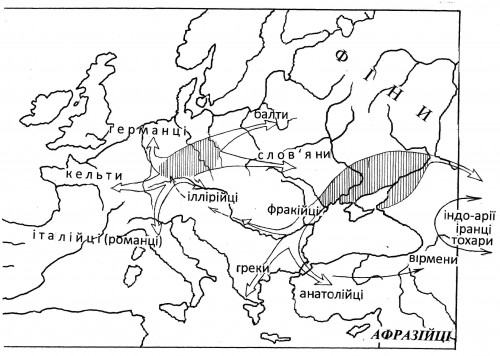
In Phrygian the group includes the Thracian dialects of Dacians, Getae, Messes, Odrises, Tribals, which in ancient times lived in Transylvania, on the Lower Danube and in the northeast of the Balkan Peninsula. They were assimilated by the Romans in the II – IV centuries. and the Slavs in the early Middle Ages. Their romanized descendants were the medieval Volokhs - the direct ancestors of modern Romanians, whose language, however, belongs to the Romance group. The Phrygians are a people whose ancestors (flies) in the XII century. BC. came from the northeast of the Balkan Peninsula to Asia Minor. I. M. Dyakonov believed that they took part in the destruction of Troy and the Hittite kingdom (History of the Ancient East, 1988, vol. 2, p. 194). Later, in the north of Anatolia, the state of Phrygia arose with the capital Gordion, which was destroyed by the Cimmerians around 675 BC. Phrygian inscriptions date from the VІІ – ІІІ centuries. BC.
Armenian language related to Phrygian, and through it is associated with the Thracian dialects of the Balkans. According to ancient sources, the Armenians came to Transcaucasia from Phrygia, and the Phrygians to Asia Minor from Thrace, which is confirmed by archaeological materials. I. M. Dyakonov considered the Armenians to be the descendants of the Phrygians, some of whom, after the fall of Phrygia, moved east to the Transcaucasia to the lands of the Huritto-Urartians. The Proto-Armenian language was partially transformed under the influence of the language of the aborigines.
The oldest Armenian texts date back to the 5th century, when the Armenian alphabet was created by Bishop Mesrop Mashtots. The language of that time (grabar) functioned until the 19th century. In the XII-XVI century. Two dialects of modern Armenian began to form: Eastern Ararat and Western Constantinople.
Tokharian language - the conventional name of i-e dialects, which in the VІ-VІІ centuries. AD functioned in Chinese Turkestan (Uyguria). Known from Xinjiang religious texts. VN Danilenko (1974, p. 234) considered the population of the Yamnaya culture to be the ancestors of the Tochars. reached Central Asia, where it was transformed into the Afanasyev culture. In the sands of Western China, mummies of light-pigmented northern Caucasians of the 1st millennium BC were found, the genome of which demonstrates a similarity to the genome of the Celts and Germans of northwestern Europe. Some researchers associate these findings with the Tochars, finally assimilated in the 10th century. the Uyghur Turks.
Germanic languages are divided into three groups: northern (Scandinavian), eastern (Gothic) and western. The oldest Germanic texts are represented by the archaic runic inscriptions of Scandinavia, which date back to the 3rd – 8th centuries. AD and bear the features of the common Germanic language before its dismemberment. Numerous Old Icelandic texts of the XIII century. preserved rich Scandinavian poetry (Elder Edda) and prose (sagas) of the X-XII centuries. Approximately from the fifteenth century. began the disintegration of the Old Norse, or Old Scandinavian, language into the West Scandinavian (Norwegian, Icelandic) and East Scandinavian (Swedish, Danish) branches.
The East German group, in addition to Gothic, known from the translation of the Bible by Bishop Ulfilah, included the now-dead languages of the Vandals and Burgundians.
The West Germanic languages include Old English (Anglo-Saxon texts of the 7th century), Old Frisian, Old Low German (Saxon texts of the 9th century), Old High German. The oldest monuments of West Germanic languages are the Anglo-Saxon epos of the VIII century. "Beowulf", known from the manuscripts of the 10th century, the High German "Song of the Nibelungs" of the 8th century, the Saxon epic of the 9th century. "Heliad".
Among the modern Germanic languages - English, which in the XI-XIII centuries. was significantly influenced by French, Flemish - a descendant of Old Frisian, Dutch - an offshoot of Old Low German. Modern German consists of two dialects - formerly separate languages (Low German and High German). Among the Germanic languages and dialects of our time, Yiddish, Boer, Faroese, Swiss should be mentioned.
Baltic languages are divided into West Baltic - dead Prussian (disappeared in the 17th century) and Yatvyag, which was widespread in the Middle Ages on the territory of North-Eastern Poland and Western Belarus, and East Baltic. The latter include Lithuanian, Latvian, Latgalian, as well as common until the XVII century. on the Baltic coast of Lithuania and Latvia Curonian. Among the dead are Selonsky and Golyadsky of the Moscow region, the Baltic language of the Upper Dnieper region. At the beginning of the Middle Ages, the Baltic languages were spread from the Lower Vistula in the west to the Upper Volga and Oka in the east, from the Baltic in the north to the Pripyat, Desna and Seim in the south. The Baltic languages have preserved the ancient Indo-European linguistic system more fully than others.
Slavic languages are divided into western, eastern and southern. East Slavic – Ukrainian, Belarusian, Russian. West Slavic are divided into three subgroups: Lehite (Polish, Kashubian, Polabian), Czech-Slovak and Serboluzhek. The Kashubian language, related to Polabian, was spread in Polish Pomerania west of the Lower Vistula. Luzhitsky is the language of the Lusatian Serbs of the upper Spree in Germany. South Slavic languages - Serbian, Croatian, Bulgarian, Slovenian, Macedonian. Slavic languages are close to each other, since they come from one Old Slavic language, which disintegrated relatively recently in the V-VII century. Presumably the bearers of Old Slavic before its collapse were the Antes and Sklavins of the territory of Ukraine, the archaeological correspondence of which was the population of the Prague-Korchak and Penkovka cultures.
The majority of modern Indo-Europeanists, recognizing the existence of the 13 mentioned groups of Indo-European languages, abandoned the simplified scheme of the ethnogenesis of Indo-European peoples according to the principle of the genetic tree, proposed back in the 19th century. Obviously, the process of glottogenesis and ethnogenesis took place not only through the transformation or division of the mother language into daughter ones, but, possibly to a greater extent, in the process of interaction of languages with each other, including non-Indo-European ones.
Scientists explain the high degree of kinship of Indo-European languages by their origin from a common genetic ancestor - the Proto-Indo-European language. It means that more than 5 thousand years ago, in some limited region of Eurasia, there lived a people, from whose language all Indo-European languages originate. Science was faced with the task of finding the homeland of the Indo-European peoples and identifying ways of their settlement. Under the Indo-European ancestral home, linguists mean the region that was occupied by the native speakers before its disintegration in the 4th millennium BC.
History of the search for the Indo-European ancestral home
The search for the ancestral homeland has a two-hundred-year dramatic history, which has been repeatedly analyzed by various researchers (Safronov 1989). Immediately after the discovery of William Jones, the ancestral home was proclaimed India, and the Sanskrit of the Rig Veda was considered almost the ancestor of all languages, which supposedly retained all the features of the Indo-European proto-language. It was believed that due to the favorable climate of India, demographic explosions took place, and surplus of population was settled westward to Europe and West Asia.
However, it soon became clear that the languages of the Iranian Avesta are not much younger than the Sanskrit of the Rig Veda. That is, the common ancestor of all i-e peoples could live in Iran or somewhere on Middle east where the great archaeological discoveries were made at this time.
In the 30-50s. XIX century Indo-Europeans were withdrawn from Central Asia, which was then considered the "forge of nations." This version was fueled by historical data on migratory waves that periodically arrived from Central Asia to Europe over the past two thousand years. This refers to the arrival in Europe of the Sarmatians, Turkic and Mongol tribes of the Huns, Bulgarians, Avars, Khazars, Pechenegs, Torks, Polovtsians, Mongols, Kalmyks, etc. In addition, at this time, the interest of Europeans in Central Asia increased, since its colonization by the Russians began from the north and the British from the south.
However, the rapid development of linguistic paleontology in the middle of the 19th century. showed the inconsistency of Asia with the natural and climatic realities of the ancestral home. The common i-e language reconstructed by linguists testified that the ancestral home was located in a region with a temperate climate and corresponding flora (birch, aspen, pine, beech, etc.) and fauna (black grouse, beaver, bear, etc.). In addition, it turned out that most of the i-e languages were localized not in Asia, but in Europe. The vast majority of ancient Indo-European hydronyms are concentrated between the Rhine and the Dnieper.
From the second half of the nineteenth century. many researchers transfer their ancestral home to Europe... The explosion of German patriotism in the second half of the 19th century, caused by the unification of Germany by O. Bismarck, could not but influence the fate of Indo-European studies. After all, most of the specialists of that time were ethnic Germans. So the growth of German patriotism stimulated the popularity of the concept of the origin of e-e from the territory of Germany.
Referring to the temperate climate of the ancestral home established by linguists, they begin to localize it precisely in Germany... An additional argument was the northern European appearance of the most ancient Indo-Europeans. Blond hair and blue eyes are a sign of aristocracy both among the Aryans of the Rig Veda and the ancient Greeks, judging by their mythology. In addition, German archaeologists came to the conclusion about uninterrupted ethnocultural development on the territory of Germany from the archaeological culture of linear-tape ceramics of the 6th millennium BC to to modern Germans.
The founder of this concept is considered L. Geiger, who in 1871, relying on the argument of beech, birch, oak, eel ash and three seasons in the reconstructed language of the Proto-Indo-Europeans, as well as on the testimony of Tacitus about the autochthonousness of the Germans to the east of the Rhine, proposed Germany as the possible ancestral home of the Indo-Europeans (Geiger, 1871).
The famous German philologist Hermann Hirt made a significant contribution to the development of the Central European hypothesis of the origin of i-e. He concluded that German is a direct descendant of Proto-Indo-European. The languages of other i-e peoples allegedly arose in the process of mixing the language of the Indo-Germans who arrived from the north of Central Europe with the languages of the aborigines (Hirt 1892).
The ideas of L. Geiger and G. Hirt were substantially developed by Gustav Kosinna. A philologist by education G.Kosinna analyzed a huge archaeological material and in 1926 published the book The Origin and Distribution of the Germans in Prehistoric and Early Historical Times (Kossinna 1926), which the Nazis used as a scientific justification for their aggression to the east. G. Kosinna traces the archaeological materials of the Neolithic and Bronze Age "14 colonial campaigns of the megalithic Indo-Europeans to the east through Central Europe to the Black Sea." It is clear that this politicized pseudoscientific version of settlement and-e collapsed along with the Third Reich.
In the 70s of the twentieth century. P. Bossch-Zhimper (1961) and G. Devoto (1962) took them out of the culture of linear-tape ceramics. They attempted to trace the phases development and from the Danube Neolithic of the 5th millennium BC before the Bronze Age and even before historical and peoples of the Early Iron Age. P. Bosch-Zhimpera considered the culture of Tripoli to be Indo-European, since, in his opinion, it was formed on the basis of the culture of linear-tape ceramics.
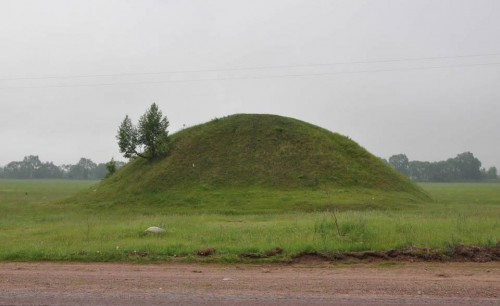
Fig. 3. Steppe mound
Almost together with Central European concept of origin i-e was born and steppe... Its supporters consider the ancestral home of the steppe from the Lower Danube to the Volga. Oswald Schrader, an outstanding German scientist and encyclopedist of Indo-European studies, is rightfully considered the founder of this concept. In his numerous works, which were published between 1880 and 1920, he not only summarized all the achievements of linguists, but also analyzed and significantly developed them using archaeological materials, including those from the Black Sea steppes. The linguistic reconstruction of the pastoralist society of the ancient Indo-Europeans has been brilliantly confirmed by archeology. O. Schrader considered the pastoralists of the Eastern European steppe in the 3rd – 2nd millennium BC, who left thousands of kurgans in the South of Eastern Europe, as proto-Indo-Europeans (Fig. 3). Since i-e languages are widespread in Europe and Western Asia, then, according to O. Schrader, their ancestral home should be located somewhere in the middle - in the steppes of Eastern Europe.
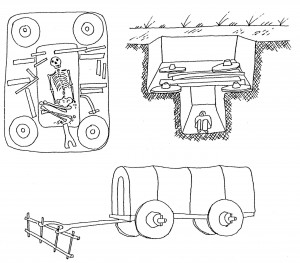
Gordon Child in his book "Aryans" in 1926 significantly developed the ideas of O. Schrader, narrowing the ancestral home of the Indo-Europeans to the steppes of Ukraine. On the basis of new archaeological materials, he showed that burials under the kurgan with ocher in the south of Ukraine (Fig. 4) were left by the most ancient Indo-European cattle breeders, who began to settle in Eurasia from here.
Being a follower of G. Child, T. Sulimirsky (1933; 1968) expressed the idea that i-e cultures Corded Ware of Central Europe, formed as a result of the migration of pit pits from the Black Sea steppes to the west.
In his book in 1950, G. Child supported T. Sulimirsky and concluded that the Yamniks migrated from the south of Ukraine through the Danube to Central Europe, where they laid the foundation for the Corded Ware cultures, from which most researchers derive the Celts, Germans, Balts, Slavs. The researcher considered the Yamnaya culture of southern Eastern Europe to be undivided and-e, which advanced not only to the Upper Danube, but also to the north of the Balkans, where they founded the Baden culture, as well as to Greece and Anatolia, where they laid the foundation for the Greek and Anatolian branches of the e-e.
A radical follower of Gordon Child was Maria Gimbutas (1970, p. 483; 1985), who considered the Yamniks to be proto-Indo-Europeans, “who moved west and south in the 5th-4th millennia BC. from the lower Don and the Lower Volga ". By Indo-Europeanization of Europe, the researcher understood the resettlement of militant carriers of the Kurgan culture of the steppes of Eastern Europe in the Balkans and in Western Europe, inhabited at that time by non-Indo-European groups of the Balkan-Danube Neolithic and the culture of funnel beakers.
Due to schematism, ignorance of linguistic data and some radicalism, the works of M. Gimbutas were criticized, but her contribution to the development of the ideas of O. Schrader and G. Child is unconditional, and the steppe version of the origin of the Indo-Europeans remains quite convincing. Among her followers, we should recall V. Danilenko (1974), D. Mallory (1989), D. Anthony (1986; 1991), Y. Pavlenko (1994), etc.
Middle eastern version of the origin of i-e was born at the dawn of Indo-European studies. In 1822 p. G.Link and F.Miller placed their homeland in Transcaucasia. Under the influence of Pan-Babylonism, T. Momsen believed that they come from Mesopotamia. However, the most detailed argumentation of the origin of i-s from the Middle East, more precisely from the Armenian Highlands, was presented in their two-volume encyclopedic work in 1984 by G.T. Gamkrelidze and V.V. Ivanov. Based on a deep analysis of a huge array of linguistic material and a generalization of the achievements of predecessors, the researchers gave a broad picture of the economy, life, material culture, beliefs of the Proto-Indo-Europeans and the natural landscape characteristics of their ancestral home.
At the same time, the placement of the ancestral home on Armenian highlands and the attempt to argue the way of settling Europe by the Indo-Europeans bypassing the Caspian Sea from the east does not stand up to criticism. Plants (aspen, hornbeam, yew, heather) and animals (beaver, lynx, black grouse, elk, crab), which are characteristic of their homeland, are not characteristic of Transcaucasia. The corresponding hydronymics are also very few in number. Not confirmed by archaeological material and travel around the Caspian Sea through Central Asia, the Lower Volga region and the steppes of Ukraine to the west.
Colin Renfrew (1987) places their homeland within the fertility crescent - in the south Anatolia... This assumption is fundamental to his concept, because it is based on the obvious fact of the migration of the early farmers of the Middle East westward to Europe and eastward to Asia. The researcher pushed away from the Nostratic concept of V. Illich-Svitych (1964, 1971), according to which the linguistic kinship of the Afrasian, Elamo-Dravidian, Ural and Sino-Caucasian families is explained by their common ancestral home in the Middle East. Pointing out that the speakers of these languages are also genetically related, K. Renfrew claims that their resettlement from the common ancestral home took place in the 8th-5th millennia BC. during the expansion of the reproduction economy (Renfrew, 1987). Without refuting the very fact of these migrations, most Indo-Europeans doubt that there were Indo-Europeans among the migrants from the Middle East.
Balkan the concept of the origin of i-e is associated with the discovery in the first half of the twentieth century. Balkan-Danube Neolithic protocivilization VII-V millennium BC It was from here, according to archeology, that the Neolithization of Europe took place. This gave the basis for B. Gornung (1956) and V. Georgiev (1966) to suggest that the Proto-Indo-Europeans formed on the Lower Danube as a result of the mixing of local Mesolithic hunters with Neolithic migrants from the Balkans. The weak point of the concept is the extreme poverty of the Mesolithic of the Lower Danube. I. Dyakonov also considered the Balkans to be the ancestral home of and-e (1982).
The ancestral home of the Indo-Europeans according to paleolinguistics
The realities and the ancestral homelands must correspond to the natural-landscape, socio-economic and cultural-historical characteristics, reconstructed with the help of linguistic analysis of the most ancient common elements of the basic vocabulary different i-e languages.
The nineteenth century was an era of bold reconstructions of society, economy, culture, the spiritual world, the natural environment of the early Indo-Europeans using the so-called linguistic paleontology. The successful works of A. Kuhn (Kuhn, 1845) and J. Grimm (Grimm, 1848) provoked numerous paleolinguistic studies, the authors of which did not always adhere to the strict rules of comparative analysis of i-e languages. Criticism of attempts to reconstruct Proto-Indo-European realities using linguistic analysis made it possible for A. Schleicher (1863) to introduce such reconstructions into the framework of strict rules. However, the present discovery of the world of the Proto-Indo-Europeans belongs to O. Schrader (1886), who generalized the results of the reconstructions of his predecessors, clarifying and checking them using materials from the Bronze Age, which at that time appeared at the disposal of researchers.
Using the method of linguistic paleontology, scientists have succeeded in reconstructing the stages of the formation of the proto-language. Based on the development of F. Saussure and A. Meillet, M.D. Andreev (1986) suggested the existence of three stages of its formation: boreal, early and late Indo-European.
Reconstructed based on general i-e vocabulary of the proto-language at the stage preceding its disintegration in the 4th millennium BC. into separate language groups were analyzed by T.V. Gamkrelidze and V.V. Ivanov (1984). The Pra-Indo-European dictionary testifies that its speakers lived in the temperate zone, albeit with a sharply continental climate, with cold winters and warm summers. They lived both in mountainous and flat areas, among rivers, swamps, coniferous and deciduous forests. We were well acquainted with the natural and climatic specifics of the steppes.
The economy of the Proto-Indo-Europeans at the time of the collapse had a cattle-raising and agricultural character. However, the significant development of cattle-breeding terminology testifies to the dominance of this particular sector in the economy. Domestic animals include a horse, a bull, a cow, a sheep, a goat, a pig, and a dog. Dominated by distant pasture cattle breeding of meat and dairy direction. The Proto-Indo-Europeans possessed perfect methods of processing livestock products: skins, wool, milk. The cult of the horse and the bull occupied an important place in ideology.
Agriculture has reached a fairly high level. The transition from hoe to the early form of arable farming was accomplished, with the use of a ral and a plow, which was pulled by a pair of oxen. They grew barley, wheat, flax. The harvest was harvested with sickles and threshed, the grain was ground with grain graters and millstones. They baked bread. They knew gardening (apples, cherries, grapes) and beekeeping. They made a variety of pottery. Were familiar with the metallurgy of copper, bronze, silver, gold. Wheeled transport played a special role: bulls and horses were harnessed to carts. They knew how to ride.
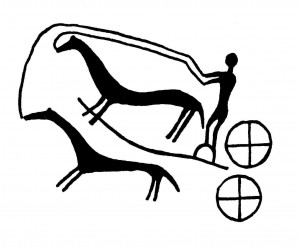
The significant role of cattle breeding in the economy determined the specifics of the social system. It was characterized by patriarchy, male dominance in the family and clan, and belligerence. Society was divided into three strata: priests, the military aristocracy, and ordinary members of the community (shepherds, farmers, warriors). The warlike spirit of the era was reflected in the construction of the first fortified settlements - fortresses. The peculiarity of the spiritual world consisted in the sacralization of war, the supreme warrior god. They worshiped weapons, a horse, a war chariot (Fig. 5), fire, a sun-wheel, the symbol of which was the swastika.
Important element i-e mythology is the world tree. By the way, this indicates that the ancestral home was a fairly wooded region. Plants and animals help localize it more precisely, the names of which are present in the late European language recreated by linguists.
Plants: oak, birch, beech, hornbeam, ash, aspen, willow, yew, pine, walnut, heather, rose, moss. Animals: wolf, bear, lynx, fox, jackal, wild boar, deer, elk, wild bull, hare, snake, mouse, louse fish, bird, eagle, crane, crow, black grouse, goose, swan, leopard leopard, lion , monkey, elephant.
The last four animals are atypical for the European fauna, although lions and leopards lived in the Balkans for another 2 thousand years. back. It has been established that the words denoting a leopard, lion, monkey and elephant, in their proto-language, came from the Middle East, most likely from the Afrasians of the Levant (Gamkrelidze, Ivanov 1984: 506, 510).
Thus, plant and animal world i-e the ancestral home corresponds to the temperate zone of Europe. This gave the reason for most modern researchers to place it between the Rhine in the west, the Lower Volga in the east, the Baltic in the north and the Danube in the south (Bosh-Gimpera, 1961; Devoto, 1962; Grossland, 1967; Gimbutas, 1970; 1985; Häusler, 1985; Gornung, 1964; Georgiev, 1966; Mallory, 1989; Childe, 1926; Sulimirski, 1968, Zaliznyak, 1994, 1999, 2012, Pavlenko, 1994, Koncha, 2004). L.S.Klein places the ancestral home within the same limits in his fundamental monograph 2007.
The reconstruction of the unified vocabulary of the Proto-Indo-Europeans gave grounds to assert that before their disintegration they already knew agriculture, cattle breeding, pottery, copper and gold metallurgy, the wheel, that is, they were at the Eneolithic stage. In other words, the disintegration took place no later than the 4th - 3rd millennium BC. (Gamkrelidze, Ivanov, 1984: 667-738, 868-870). The discovery of the Hittite, Palai, Luwian individual and languages due to deciphering of texts from the library of the Hittite kingdom capital Hatusa II millennium BC. Since there is convincing archaeological evidence that the Hittites came to Anatolia at the beginning of the 3rd millennium BC, the disintegration of the Proto-Indo-Europeans into separate branches began no later than the 4th millennium BC.
G. Kühn believed that Proto-Indo-European unity existed in the Upper Paleolithic, and linked it with the Madeleine culture of France (Kühn, 1932). S.V. Koncha sees undivided Indo-Europeans in the early Mesolithic of the lowlands between the Lower Rhine in the west and the Middle Dnieper in the east (Koncha, 2004).
Linguistic contacts of Proto-Indo-Europeans
Archaic i-e hydronymics is concentrated in Central Europe between the Rhine in the west, the Middle Dnieper in the east, the Baltic in the north, and the Danube in the south (Gamkrelidze, Ivanov 1984, p. 945).
It is more accurate to localize the ancestral homeland allowed by the identified in i-th languages traces of contacts with the Finno-Ugrians, Kartvelians and the peoples of the Middle East (Prahatts, Prahuritts, Afrasians, Sumerians, Elamites). Linguistic analysis indicates that the Praffin-Ugrians before their disintegration in the 3rd millennium BC. borrowed from i-e a significant amount of agricultural terminology (pig, piglet, goat, grain, hay, ax-hammer, etc.). Diverse i-e vocabulary is present in the Kartvelian languages (Georgian, Mingrelian, Svan) (Gamkrelidze, Ivanov, 1984: 877). Particularly important for the localization of the i-e ancestral homeland is the presence in their languages of parallels with the languages of the peoples of the Middle East.
The famous linguist V. Illich-Svitych (1964) noted that a certain part of the agrarian and livestock vocabulary was borrowed from the Prosemites and Sumerians. As an example of Prosemitic borrowings, the researcher named the words: tauro - bull, gait - goat, agno - lamb, bar - grain, cereal, dehno - bread, grain, kern - millstone, medu - honey, sweet, sekur - ax, nahu - vessel , ship, haster - star, septm - seven, klau - key, etc. According to V. Illich-Svitych, the words were borrowed from the Sumerian language: kou - cow, reud - ore, auesk - gold, akro - niva, duer - doors, hkor - mountains, etc. (Gamkrelidze, Ivanov, 1984: 272–276).
However, especially a lot of agricultural and livestock terminology, names of food products, household items and-e were borrowed from the prahatts and prachurites, whose ancestral home is located in Anatolia and in the upper reaches of the Tigris and Euphrates. SA Starostin (1988, pp. 112–163) believes that the roots of klau, medu, akgo, bar and some others cited by V. Illich-Svitych are not at all Prosemitic or Sumerian, but Hutto-Hurite. In addition, he suggests numerous examples of Hutto-Huritic vocabulary in other languages. Here are just a few of them: ekuo - horse, kago - goat, porko - pig, hvelena - wave, ouig - oats, hag - berry, rughio - rye, lino - lion, kulo - stake, spis, gueran - millstone, sel - village, dholo - valley, arho - space, area, tuer - cottage cheese, sur - cheese, bhar - barley, penkue - five and many others. An analysis of these linguistic borrowings indicates that they occurred in the process of direct contacts of the Proto-Indo-Europeans with the more developed Prahatto-Hurites no later than the 5th millennium BC. (Starostin, 1988, pp. 112-113, 152-154).
The nature of all these expressive linguistic parallels between the Proto-Indo-European, on the one hand, and with the Proto-Ugric, Pro-Kartvelian, languages of the mentioned peoples of the Middle East, on the other, indicates that they are the result of close contacts of the Proto-Indo-Europeans with these peoples. That is, the sought-after ancestral home should have been located somewhere between the homelands of these ethnic groups, which makes it possible to more accurately localize it. It is known that the ancestral home of the Finno-Ugrians is the forest-steppe between the Don and the Urals, the Kartvels are the Central Caucasus. Regarding the mentioned Middle Eastern borrowings in i-th languages, their source, in our opinion, could be the Balkan-Danube Neolithic, including the carriers of the Trypillian culture of the Right-Bank Ukraine. After all, the Neolithic colonization of the Balkans and the Danube took place in the 6th - 6th millennia BC. from Asia Minor, the homeland of the Hatto-Hurites.
Analysis of modern versions i-e ancestral home
Nowadays, five regions claim the honorary right to be called their ancestral home: Central Europe between the Rhine and the Vistula (I. Geiger, G. Hirt, G. Kosinna, P. Bosch-Jimpera, G. Devoto), the Middle East (T. Gamkrelidze, V. Ivanov, K. Renfrew), the Balkans (B. Gornung, V. Georgiev, I. Dyakonov) and the forest-steppe and steppe zones between the Dniester and the Volga (O. Shrader, G. Child, T. Sulimirsky, V. Danilenko , M. Gimbutas, D. Mallory, D. Anthony, Y. Pavlenko). Some researchers unite Central Europe with the Eastern European steppes up to the Volga into their ancestral homeland (A. Hoisler, L. Zaliznyak, S. Koncha). Which of these versions is more plausible?
The concept of the origin of i-e s Central Europe(lands between the Rhine, Vistula and the Upper Danube) was especially popular at the end of the XIX - in the first half of the XX century. As noted, its founders were L. Geiger, G. Hirt, G. Kosinna.
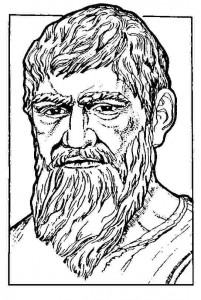
The constructions of the aforementioned German researchers are based on the coincidence of the natural and climatic realities of the Proto-Indo-European dictionary with the nature and temperate climate of Central Europe, as well as the North European appearance of the early I-e (Fig. 6). The fact of the coincidence of the main area of hydronymics and the territories of several archaeological cultures is also important. This refers to the cultures of linear-banded ceramics, funnel-shaped cups, spherical amphorae, corded ceramics, which from the 6th to the 2nd millennium BC. successively replaced each other in the indicated territories of Central Europe.
Nobody doubts the Indo-European character of Corded Ware cultures now. Their genetic forerunners were the funnel beaker and globular amphora cultures. However, there is no reason to call the Indo-European culture of linear-tape ceramics, since it lacks the defining features reconstructed by linguists: the cattle-breeding direction of the economy, the dominance of men in society, the warlike nature of the latter - the presence of the military elite, fortresses, the cult of war, weapons, a war chariot, horse, sun, fire, etc. In our opinion, the carriers of the traditions of the linear-tape ceramics culture belonged to the Neolithic circle of the Balkans, the non-Indo-European character of which is recognized by most researchers.
The location of the ancestral home in Central Europe is hindered by the presence in the i-th languages of traces of close linguistic contacts with the Proto-Kartvelians of the Caucasus and the Finno-Ugric peoples, whose homeland was the forest-steppe between the Don and the Southern Urals. If the Proto-Indo-Europeans lived in Central Europe, then how could they contact the inhabitants of the Caucasus and the Don region?
Most modern scientists consider Central Europe to be the homeland of the corded cultures of the 3rd-2nd millennia BC, the carriers of which were the ancestors of the northern branches of the Ie: Celts, Germans, Balts, Slavs. However, Central Europe could not be the homeland of all i-e peoples, because the southern i-e (Illyrians, Phrygians, Greeks, Hittites, Italics, Armenians), as well as the eastern (Indo-Iranians), cannot be derived from the cords either linguistically or archaeologically. ... In addition, in the forest-steppe and steppes Ukraine and appeared earlier than the most ancient cords - no later than the end of the 5th millennium BC. (srednestogovtsy).
Near East also, it could not have been the ancestral home, because here was the homeland of non-Indo-European ethnic groups: the Hatti, Hurite, Elamite, Afrasian linguistic communities. Mapping of i-e languages shows that this region was the southern periphery of their ecumene. I-e Hittites, Luwians, Palaians, Phrygians, Armenians appear here quite late - in the III-II millennium BC, that is, after the disintegration of the Proto-Indo-European language in the IV millennium BC. Unlike Europe, there is almost no hydronymics here.
The cold continental climate of the ancestral home with frosty snowy winters does not correspond to the realities of the Middle East. Almost half of the plants and animals that appear in the i-th language are missing here (aspen, hornbeam, linden, heather, beaver, black grouse, lynx, etc.). On the other hand, the i-e dictionary does not contain the names of typical representatives of the Middle Eastern fauna and flora (cypress, cedar, etc.). As for the lion, leopard, monkey and elephant, their names were borrowed from the Prosemitic language. If these animals were typical for their ancestral home, then why were they borrowed from their southern neighbors? The Proto-Indo-Europeans could not live in the Middle East because the strong influence of their language was traced among the Finno-Ugric peoples, whose homeland is located too far north of the Middle East, which excludes the possibility of contact with them.
Assuming that i-e happens to Balkan, we will ignore their linguistic ties not only with the Finno-Ugric peoples, but also with the Kartvelians of the Caucasus. It is impossible to withdraw from the Balkans their eastern branch - the Indo-Iranians. This is contradicted by the data of both archeology and linguistics. I-e hydronyms are known only in the north of the Balkans. Most of them are distributed to the north, between the Rhine and the Dnieper. Hypothesis about origin i-e from the Balkan Neolithic farmers is also contradicted by the fact that the appearance first and e in the historical arena in the IV – III millennium BC. NS. coincided with the aridization of the climate, the separation of cattle breeding into a separate industry and its spread over the gigantic expanses of Eurasia and, finally, with the collapse of the agricultural Neolithic of the Balkans and the Danube. What gives reason to some researchers to consider the Balkan Peninsula as the ancestral home?
The famous researcher Colin Renfrew rightly believes that a grandiose linguistic phenomenon dissemination and languages should be responsible for an equally large-scale socio-economic process. According to the scientist, such a global phenomenon in primitive history was the Neolithization of Europe. This refers to the resettlement of ancient farmers and livestock breeders from the Middle East to the Balkans and further to Europe.
R. Sollaris (1998, pp. 128, 129) gave a reasoned criticism of K. Renfrew's attempts to derive i-e from the Middle East from the standpoint of new genetic research. Biomolecular analysis of paleoanthropological and paleozoological remains demonstrates the correspondence of changes in the genome of Europeans and domesticated animals of Middle Eastern origin. This is convincing evidence of the colonization of Europe by the Neolithic population from the Middle East. However, substratum phenomena in Greek and other i-e languages testify that they came to the Balkans after their development by the Neolithic colonists from Anatolia. The genetic kinship of the peoples of the Nostratic family of languages of Eurasia is explained, according to R. Sollaris (1988: 132), by the existence of common ancestors of the population of Eurasia, who, at the beginning of the Upper Paleolithic, 40 thousand years ago, settled from the Western Mediterranean to the west and east.
The fact of the overflow of the "surplus" of the early agricultural population from the Middle East to the Balkans and further to Europe is beyond doubt. However, was it Indo-European? After all, archeology testifies that from the first centers of the manufacturing economy in the south of Anatolia, in Syria, Palestine, in the Zagro mountains, not i-e grows, but Elamite, Hatti, Huritic, Sumerian and Afrasian communities. It is in the latter that the material and spiritual culture and economy of the Neolithic farmers of the Balkans have direct parallels. Their anthropological type is close to that of the Neolithic inhabitants of the Near East and differs significantly from the anthropology of the first reliable Indo-Europeans who lived in the 4th millennium BC. NS. in Central Europe (Corded Ware culture) and in the forest-steppe between the Dnieper and the Volga (Sredniy Stog and Yamnaya cultures). If the Neolithic population of the Balkans and the Middle East was a carrier of the southern European or Mediterranean anthropological type (gracile, short Caucasians), then the Indo-Europeans mentioned were massive, tall northern Caucasians (Potekhina 1992) (Fig. 6). Clay figurines from the Balkans depict people with a large nose of a specific shape (Zaliznyak, 1994: 85), which are an important defining feature of the Eastern Mediterranean anthropological type, according to V.P. Alekseev (1974: 224, 225).
A direct descendant of the Neolithic proto-civilization of the Balkans was the Minoan civilization, which formed on the island of Crete around 2000 BC. According to M. Gimbutas, the Minoan linear letter "A" comes from the sign system of the Neolithic farmers of the Balkans of the 4th millennium BC. NS. Attempts to decipher the texts of the Minoans showed that their language belongs to the Semitic group (Gimbutas 1985; Gamkrelidze, Ivanov 1984, pp. 912, 968; Renfrew 1987, p.50). Since the Minoans were descendants of the Balkan Neolithic, the latter could in no way be Indo-European. Both archaeologists and linguists came to the conclusion that before the appearance of the first and-e in Greece in the II millennium BC. NS. non-Indo-European tribes lived here.
Thus, culturally, linguistically, anthropologically and genetically, the Balkan Neolithic was closely related to the non-Indo-European Neolithic proto-civilization of the Near East. It seems that the aforementioned significant number of agricultural terms of Middle Eastern origin in i-th languages is explained by the intense cultural influence of the Balkan farmers, genetically related to the Middle East, on the ancestors of i-e - the aborigines of Central and southern Eastern Europe.
Steppe version of the origin of the Indo-Europeans
The most reasoned and popular in our time versions of the location of the ancestral home of i-e peoples is the steppe, according to which i-e originated in the steppes between the Dniester, the Lower Volga and the Caucasus. Its founders were the aforementioned O. Schrader (1886) and G. Child (1926, 1950), who in the late XIX - early XX century. expressed the idea that the first impetus for the Indo-Europeanization of Eurasia came from the most ancient pastoralists of the northern Black Sea steppes and forest-steppes. Later, this hypothesis was fundamentally substantiated and developed by T. Sulimirsky (1968), V. Danilenko (1969; 1974), M. Gimbutas (1970; 1985), D. Mallory (1989), D. Anthony (1991). Yuri Pavlenko (1994) was her supporter.
According to this version the oldest formed in the south of Ukraine as a result of complex historical processes that led to the separation of cattle breeding into a separate branch of the primitive economy. Due to the long agrarian colonization of the Balkans and the Danube by the Middle Eastern hoe farmers, the reserves of hoe farming in Central Europe were exhausted. Further expansion of the reproducing economy in the steppe and forest zones required an increase in the role of livestock raising. This was facilitated by the progressive aridization of the climate, which led to a crisis in the agricultural economy of the Balkans and the Danube, at the same time creating favorable conditions for the spread of various forms of animal husbandry. The same was facilitated by the clearing of deciduous forests of Central Europe and Right-Bank Ukraine by Neolithic farmers in the 1st V-V thousand... BC e., since the wastelands in the place of the former fields became potential pastures.
Neolithic hoe farmers grazed their few animals near villages. During the ripening of the crop, they were driven away from the crops. So, the most ancient distant-pasture form of cattle breeding was born. She tends to graze animals in the summer on pastures far from permanent settlements. It was this very ancient type of cattle breeding that made it possible for societies with a reproducing economy to colonize not only the Eurasian steppes, but also advance into the forests of central Europe.
The separation of cattle breeding from the ancient mixed agricultural and livestock economy of the Balkan-Danube Neolithic into a separate industry began in the south of Ukraine, on the border of fertile black soil occupied by hoe farmers on the right bank of the Dnieper and the Eurasian steppes, which have since become the home of mobile and warlike pastoral peoples. Thus, in the IV millennium BC. NS. the territory of Ukraine became a border between the sedentary peace-loving farmers of the Danube region and the mobile, warlike herders of the Eurasian steppes.
It was in the south of Ukraine that the agricultural protocivilization of the Balkans and the Danube through its northeastern outpost - the Trypillian culture - directly influenced the ancestors of the most ancient pastoralists - Mesolithic and Neolithic hunters and fishermen of the forest-steppe basins of the Dnieper and Seversky Donets. The latter received from the Balkan-Danube descendants of the most ancient farmers and pastoralists of the Middle East not only the skills of a reproduction economy, but also the Middle Eastern agricultural terminology traced by linguists in other languages (Illich-Svitych 1964; 1971; Starostin, 1988). Localization in the steppes and forest-steppe between the Dniester, the Lower Don and the Kuban of the first shepherds-cattle breeders is in good agreement with the three main directions of Proto-Indo-European linguistic contacts. In the west, they directly bordered on the carriers of agricultural vocabulary of Middle Eastern origin (Trypillians), in the northeast - the Finno-Ugric, and in the southeast - the Kartvelian vocabulary of the Caucasus (Fig. 2).
M. Gimbutas placed the homeland of cattle breeding and its first i-e carriers in the Middle Volga region, with which it is difficult to agree. After all, cattle breeding was born from integrated hoe farming in the process of separation into an independent branch of the economy. That is, this could happen only under the condition of direct and close contacts of the first pastoralists with large agrarian communities, such as the early agricultural proto-civilization of the Balkans and the Danube.
There was nothing like this in the Volga region. The closest center of agriculture lay 800 km south of the Middle Volga region behind the Great Caucasus Range in the basins of the Kura and Aras rivers. If the first pastoralists had borrowed the production economy along with the agrarian terminology from there, the latter would have been mainly Kartvelian. However, a significant number of common Indo-European pastoralism and agricultural terms are not of Caucasian, but of Anatolian origin. Thus, they were directly borrowed by the Proto-Indo-Europeans from the Neolithic population of the Balkans and the Danube - the direct descendants of the Neolithic colonists from Anatolia, most likely the Prahatto-Hurites.
The cattle-breeding skills received from the Trypillians took root and quickly developed into a separate industry in the favorable conditions of the steppes and forest-steppes of the Left-Bank Ukraine. Herds of cows and flocks of sheep moved intensively in search of pastures, which required a mobile way of life from herders. This stimulated the rapid spread of wheeled transport, domestication in the 4th millennium BC. NS. horses, which, together with bulls, were used as draft animals. The constant search for pastures led to military clashes with neighbors, which militarized society. The pastoral economy turned out to be very productive. One shepherd grazed a flock that could feed many people. In conditions of constant conflicts over pastures and cows, the surplus of male workers was transformed into professional warriors.
For pastoralists, unlike farmers, not a woman, but a man became the main figure in the family and community, since all life support lay with the shepherds and warriors. The possibility of accumulating livestock in the same hands created conditions for the property differentiation of society. The military elite appears. The militarization of society determined the construction of the most ancient fortresses, the spread of the cults of the supreme god of the warrior and shepherd, war chariot, weapons, horse, sun-wheel (swastika), fire.
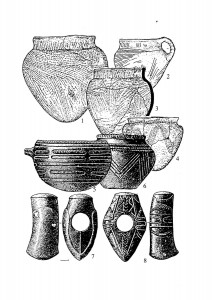
Rice. 7. Pottery of the pit (1-4), as well as dishes and war hammers (vajras) of the catacomb cultures of the 3rd-2nd millennia BC. South of Ukraine. Catacomb vessels and axes - Ingul culture
These ancient cattle breeders of the south of Eastern Europe ІV-ІІІ millennium BC. NS. were not yet real nomads who spent their whole lives on horseback or on a cart in constant migrations behind herds and herds of animals. Nomadism, as a way of nomadic life and a developed form of cattle-breeding economy, was finally formed in the steppes only at the beginning of the 1st millennium BC. At the heart of the economy of the steppe inhabitants of the IV-III millennium BC. NS. there was less mobile distant-pasture cattle breeding. It provided for a more or less sedentary residence of women and children in stationary settlements in the river valleys, where they cultivated barley, wheat, raised pigs, goats, and fished. The male population spent more and more time with herds of cows, sheep and horses on summer steppe pastures. In the spring, the animals, accompanied by shepherds and armed guards, were driven far into the steppe and only in the fall were returned home for the winter. This semi-sedentary way of life quickly acquired more and more mobile forms due to the growing role of livestock raising.
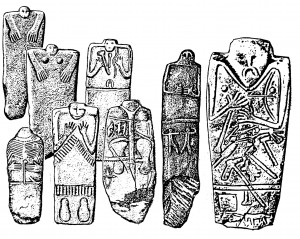
These early semi-nomadic pastoralists left few settlements, but a large number of mounds. Especially a lot of them were poured by holes (hundreds of thousands) in the 3rd millennium BC. NS. Archaeologists recognize them by the so-called steppe burial complex. Its most important elements are a burial mound, placing the deceased in a grave pit in a crumpled position, filling the buried with red ocher powder. Coarse clay pots, often ornamented with cord prints and pricks, and weapons (stone war hammers and maces) were placed in the grave (Fig. 7). In the corners of the pit, wheels were placed, symbolizing the funeral carriage, and often its parts (Fig. 4). Stone anthropomorphic steles are found in the mounds, which depict the patriarch of the family with the corresponding attributes of a warrior-leader and a shepherd (Fig. 8). An important sign of the first and-e of the south of Ukraine is the domestication of the horse, traces of which can be traced in the forest-steppe Dnieper region from the IV-III millennium BC. NS. (Telegin 1973).
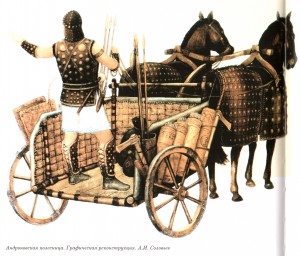
The unprecedented settlement of the most ancient and-e from the south of Ukraine in the endless steppe expanses to the Middle Danube in the west and to Altai in the east is explained by the cattle-breeding economy, the spread of wheeled transport - carts and war chariots (Fig. 9), draft animals (bull, horse) and later equestrianism, which determined the mobile way of life, belligerence and the grandiose scale of the expansion of the early and-e (Fig. 2).
From the Rhine to the Donets
However, the limitation of i-e ancestral home only to the steppes and forest-steppes of Ukraine does not explain why the main body of the most ancient i-e hydronymics lies in Central Europe between the Rhine and the Dnieper. Natural realities such as mountains, swamps, the spread of aspen, beech, yew, heather, beavers, black grouses, etc. do not fit in with the south of Ukraine. These elements of the natural environment are more typical for the temperate and cool climate of Central Europe than for the sultry steppes of the Black Sea region. And the North Caucasian appearance of the first and-e, as evidenced by the most ancient written sources, does not fit with the Black Sea region.
These contradictions are removed if we assume the existence of a single ethnocultural substrate between the Lower Rhine and Donets, on which in the V-IV millennium BC. the earliest Indo-Europeans of the Black Sea region and Central Europe began to form. Such a substrate began to take shape in the last third of the XX century. in the course of research of Mesolithic sites in the North German, Polish, Polesskaya lowlands, in the basins of the Neman and Donets.
The Central European lowlands, which stretch from the Thames basin through northern Germany, Poland, Polesie to the Middle Dnieper, starting from the final Paleolithic and up to the Middle Ages, were a kind of corridor along which migration waves rolled from west to east. Reindeer hunters of the Lingbi culture passed the first route from Jutland to the Dnieper 12 thousand years ago (Fig. 10). They settled the Central European lowlands that had just been freed from the glacier, giving rise to related cultures of reindeer hunters of the last millennium of the Ice Age: Ahrensburg in Northern Germany, Svider and Krasnoselie of the Vistula, Neman, Pripyat, Upper Dnieper basins.
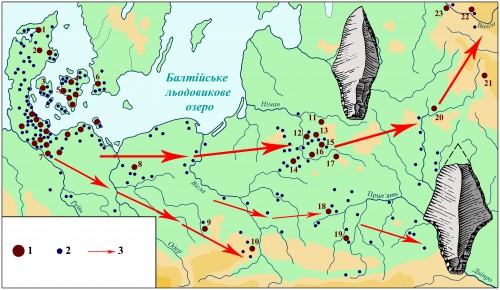
Rice. 10. Map of the distribution of monuments of the Bromme-Lingbi type, about 11 thousand years ago. back. (Zaliznyak, 2005, p. 45) Symbols: 1- Lingbi culture sites, 2- Lingbi arrowheads, 3- migration directions of the Lingbi culture population, 4- southern and eastern border of the outwash lowlands.
The Mesolithic of the Central European lowlands began with a new wave of settlers to the east, which led to the addition of the cultural region of Duvensie. It includes related early Mesolithic cultures Star Kar England, Duvensie Germany, Klosterlund Denmark, Komornitsa Poland, Kudlaevka Polesie and the Neman basin (Fig. 11, 12).
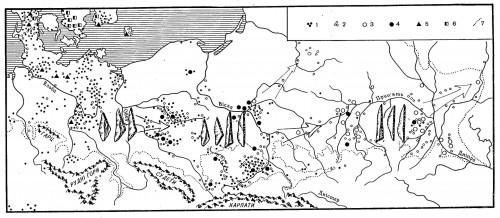
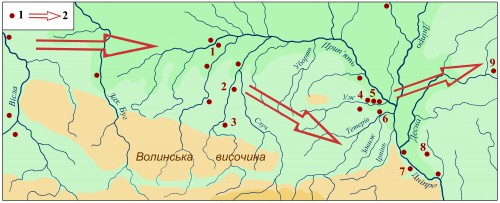
The migration in the Atlantic period of the Holocene of the carriers of the Maglemose culture traditions of the Southwestern Baltic was especially powerful. In the Boreal in the 7th millennium BC Maglemose was transformed into the Swadborg culture of Jutland, whose population due to the transgression of the Baltic around 6000 BC. migrated to the east, where it took part in the formation of the Yanislavsky culture of the Vistula, Neman and Pripyat basins (Fig. 13) (Kozlowsky 1978, p. 67, 68; Zaliznyak 1978, 1984, 1991, pp. 38-41, 2009, p. 206 -210). At the end of the 6th millennium BC. the carriers of the Yanislavsky traditions advanced along the Dnieper valley into Nadporozhye and further east to the Seversky Donets basin (Fig. 15). This is evidenced by the map of the distribution of characteristic Yanislavsky points (Fig. 14).
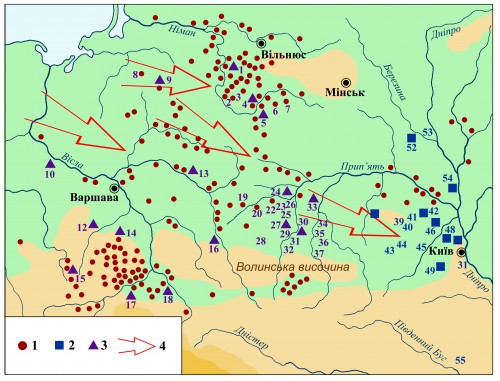
Rice. 13. Map of the distribution of the monuments of the Yanislavsky culture of the 6th-5th millennia BC. The Neman basin (Zaliznyak, 1991: 29)
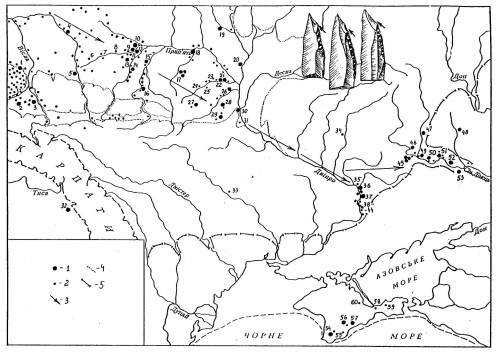
Rice. 14. Map of the distribution of points with a micro-incisor chip on the plates in the territory of Ukraine. (Zaliznyak, 2005, p. 109) Symbols: 1-sites with a series of points, 2-points with 1-3 points, 3-direction of migration from the South Baltic in the VII-V thousand BC, 4-border Polesie, 5-southern border of forests in the Atlanticum.
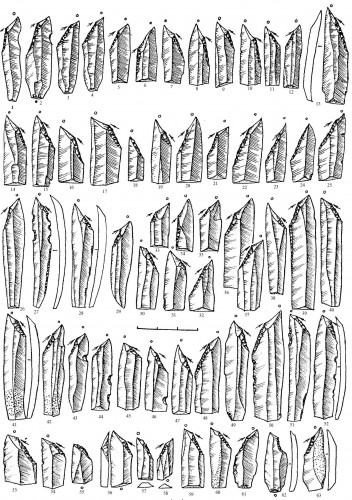
Rice. 15. Rips on plates with micro-incisor chips from sites in Ukraine. Type Janislavitsa and the like. (Zaliznyak, 2005, p. 110)
The penetration of forest hunters of Maglemose cultural traditions from Polesie to the south was probably stimulated by a shift southward along the river valleys of deciduous forests due to the general warming and humidification of the climate at the end of the Mesolithic. As a result of the spread of forest and forest-steppe biotopes with the corresponding fauna along the river valleys up to the Black and Azov Seas, conditions have been created for the advancement of forest hunters of the Yanislavsky culture to the south and southeast of Ukraine.
So, in the VI-V millennium BC. formed the late Mesolithic cultural community of postmaglemose, which covered the lowlands from Jutland to the Seversky Donets (Fig. 16). It included the Mesolithic cultures of postmaglemose in the Western and Southern Baltic, Yanislavitsa of the Vistula, Neman, and Pripyat basins, as well as the Donetsk culture of the Seversky Donets basin. The flint inventory of these cultures convincingly testifies to their relationship and genesis on the basis of the Baltic Mesolithic. Numerous finds of microliths characteristic of the Mesolithic of the Baltic and Polesye in the Nadporozhye and even on the Seversky Donets indicate that migrants from the Baltic reached the Donets (Zaliznyak, 1991: 40, 41; 2005: 109–111).
In the 5th millennium BC. on the basis of postmaglemose, but under the southern influence of cultural communities of the Balkan-Danube Neolithic, a group of forest Neolithic cultures was formed: Ertebelle of the South-Western and Tsedmar of the Southern Baltic, Dubichai of the Neman basin, Volyn basin of the Pripyat and Neman, Dnieper-Donetsk of the Middle Dnieper region and Donetsk Seversky Donets (Fig. . 16). Among the Neolithic donors of the mentioned cultures of the forest Neolithic of the German, Polish, Polosskaya lowlands and the Middle Dnieper region, a special role was played by the cultures of linear-tape ceramics and Cucuteni-Tripolye.
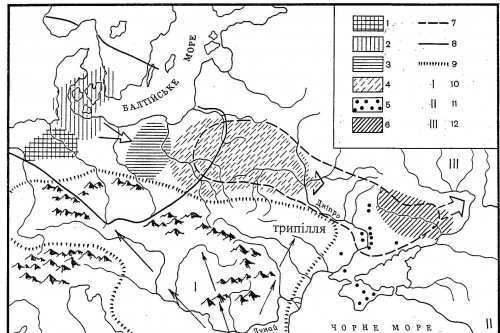
The existence of a cultural and genetic community on the plains from the Lower Rhine to the Seversky Donets is confirmed not only by archeology. The above-mentioned autochthonous hunting communities of the Central European lowlands and the Dnieper region were linked not only by a single type of forest hunting and fishing economy and material culture, but also by an anthropological type of population. Anthropologists have long written about the penetration of northern Caucasians from the Western Baltic to the Middle Dnieper and South-East of Ukraine in the Mesolithic and Neolithic (Gokhman 1966, Conduktorova 1973). Comparison of materials from the Mesolithic and Neolithic burial grounds of the Dnieper region of the 6th-4th millennium BC. with the synchronous burials of Jutland testifies to both a certain cultural and genetic relationship of the population that left them. Not only the funeral rite, but also the anthropological type of the buried were similar (Fig. 4). They were tall, very massive, broad-faced northern Caucasians, buried in an extended position on their backs (Telegin, 1991, Potekhina 1999). In the 5th millennium BC. This population moved through the forest-steppe belt to the Left-Bank Ukraine and to the east of the Middle Volga region (Sezzhee burial ground), forming the Mariupol cultural community, represented by numerous Mariupol-type burial grounds with numerous osteological remains of massive northern Caucasoids (Telegin, 1991). The population of the early Indo-European communities of the 4th millennium BC originated from this anthropological massif. - Middle Stog and Yamnaya cultures of the forest-steppe Ukraine.
Thus, in the VI-V millennium BC. The northern European hunting population, which from the end of the Ice Age lived in the low-lying forest expanses of the South Baltic and Polesie, moved along the left bank of the Dnieper into the Seversky Donets basin. A huge ethnocultural community was formed, which stretched from Jutland to the Donets for two thousand km and consisted of related cultures of hunters and fishermen. Under the influence of agricultural cultures of the Balkan-Danube Neolithic from the south, the post-Maglemese Mesolithic community passed to the Neolithic stage of development. Due to the spread of the steppes due to the aridization of the climate, these aboriginal societies of northern Caucasians began to switch to cattle breeding and were transformed into the most ancient and-e cultures of the 4th millennium BC. (srednestogovskaya on the left bank of the Dnieper and funnel-shaped cups in Central Europe).
Thus, the most ancient Indo-Europeans of the IV-III millennium BC. carriers of the Sredny Stog and Yamnaya cultures (arose on the basis of the Dnieper-Donetsk and Mariupol cultures) in the east and the cultures of funnel-shaped beakers and spherical amphorae (descendants of the Ertebelle culture) in the west belonged to the Northern European anthropological type. At the same time, the carriers of these early Indo-European cultures show some gracilization of the skeleton, which indicates their formation on the basis of the local northern Caucasians under the conditions of a certain influx of a more gracile non-Indo-European population from the Danube colonized by farmers. Massive northern Caucasians, according to EE Kuzmina (1994, pp. 244-247), were also the carriers of the Andronov culture of Central Asia (Fig. 9).
The North European appearance of the early and-e is confirmed by written sources and mythology, which testify to the light pigmentation of the Indo-Europeans of the 2nd millennium BC. So, in the Rig Veda, the Aryans are characterized by the epithet "Svitnya", which means "light, fair-skinned." The hero of the famous Aryan epic "Mahabharata" often has "lotus blue" eyes. According to Vedic tradition, a real brahmana should have brown hair and gray eyes. In the Iliad, Achaeans have golden-haired blondes (Achilles, Menelaus, Odysseus), Achaean women and even the goddess Hera are blonde. The god Apollo was also depicted as golden-haired. On Egyptian reliefs from the time of Thutmose IV (1420-1411 BC), Hittite charioteers (mariana) have a Nordic appearance, in contrast to their Armenoid squires. In the middle of the 1st millennium BC. to the king of Persia from India, it was as if the fair-haired descendants of the Aryans came (Lelekov, 1982, p. 33). According to the testimony of ancient authors, the Celts of Central and Western Europe were tall blondes. In addition, the legendary Tochars of Shinjiang in Western China belonged to the Northern European type, not surprisingly. This is evidenced by their mummified bodies, which date back to around 1200 BC. and Tocharian wall paintings VII-VI century. AD Ancient Chinese chronicles also testify to blue-eyed blondes who in ancient times lived in the deserts of Central Asia.
The belonging of the most ancient Indo-Europeans to the northern Caucasians is consistent with the localization of the ancestral home between the Rhine and the Seversky Donets, where by the 6th-5th millennia BC. according to the data of modern archeology, an ethnocultural community was formed (Fig. 16), on the basis of which the most ancient cultures arose (Mariupol, Sredniy Stog, Yamnaya, funnel-shaped cups, spherical amphorae).
Summing up, it can be assumed that the ancestral home of i-e was probably the German, Polish, Dnieper lowlands and the Donets basin. At the end of the Mesolithic in the VI-V millennium BC. these territories were inhabited by massive northern Caucasians from the Baltics. In the 5th millennium BC. on their genetic basis, a group of related Neolithic cultures is formed, which developed under the progressive influence of the agricultural protocivilization of the Balkans. As a result of contacts with the latter, in the conditions of aridization of the climate and expansion of the steppes, there was a transformation of the autochthonous Proto-Indo-Europeans into a proper Indo-European early pastoralist mobile society (Zaliznyak 1994, pp. 96-99; 1998, pp. 216-218, 240-247; Zaliznyak, 1997, p .117-125; 2005). An archaeological marker of this process is the beginning of formation in the Azov and Black Sea steppes at the end of the 5th – 4th millennium BC. cattle-breeding barrow burial rite (barrow, burials with skeletons twisted and painted with ocher, anthropomorphic steles with images of weapons and shepherd's attributes, traces of the cult of a horse, bull, wheeled transport, weapons, etc.).
If the author of these lines considers the post-Maglemese ethnocultural community of the 6th-5th millennium BC identified by him. (Fig. 16) by the Proto-Indo-Europeans, the substrate on which the Indo-Europeans themselves were formed, then another Ukrainian researcher S. V. Koncha considers the carriers of postmaglemose as already formed Indo-Europeans before their disintegration into separate ethno-linguistic branches. According to S.V. Konchi, “there are good reasons to date the Indo-European community to the Early Mesolithic (VIII-VII millennium BC), and the beginning of its decay to be associated with the settlement of the Yanislavsky population to the east, in Polesie, and further, to the Donets basin in the 6th – 5th millennium BC. " The researcher believes that defining for the early i-e cultural the complex (mobile pastoral cattle breeding, burial mounds, cults of the horse, bull, sun wheel, weapon, patriarch, shepherd-warrior, etc.) was acquired later, after the collapse of the Proto-Indo-European community in the 4th-3rd millennium BC AD (Koncha, 2004, pp. 191-203).
One way or another, in the lowlands from the Lower Rhine in the west to the Middle Dnieper and the Seversky Donets in the east, a cultural and historical community is archeologically traced, which began to form with the end of the Ice Age and which may have been the ethnocultural basis of the Indo-European group of peoples.
The problem of the Indo-European homeland is far from its final solution. The above considerations will undoubtedly be corrected and refined as new facts become available and the latest scientific methods are applied to solving the problems of Indo-European studies.
LITERATURE:
Akashev K.A., Khabdulina M.K.... Antiquities of Astana: Settlement Bozok.-Astana, 2011.- 260 p.
Alekseev V.P. Geography of the human races. -M., 1974.- 350 p.
Andreev N.D. Early Indo-European language. - M., 1986.
Gamkrelidze T.V., Ivanov V.V. Indo-European language and Indo-Europeans. - Vol. 1, 2. - Tbilisi, 1984. - 1330 p.
Gornung B.V. On the question of the formation of the Indo-European linguistic community. - M., 1964.
Gokhman I.I. Population of Ukraine in the Mesolithic and Neolithic Era (Anthropological sketch) .- M., 1966.
Danilenko V.N. Neolithic of Ukraine. - K., 1969. - 260 p.
Danilenko V.N. Eneolithic of Ukraine. - K., 1974.
Dyakonov I.M. About the ancestral home of the speakers of Indo-European dialects // Bulletin of ancient history.- № 4.- 1982.- P.11-25.
Zaliznyak L.L. Ore construction Mesolithic culture // Archeology. - 1978. - No. 25. - S. 12 - 21.
Zaliznyak L.L... Mesolithic of South-Eastern Polesie. - K .: Naukova Dumka, 1984. - 120 p.
Zaliznyak L.L... Population of Polesie in the Mesolithic. - K., 1991.-190 p.
Zaliznyak L.L. Narisi old-time history of Ukraine.-K., 1994.- 255 p.
Zaliznyak L.L... Pre-history of Ukraine X –V yew. BC. - K., 1998 .-- 307 p.
Zaliznyak L.L. The First History of Ukraine. - K., 1999. - 264 p.
Zaliznyak L.L.
Zaliznyak L.L. Old history of Ukraine. - K., 2012. - 542 p.
Zaliznyak L.L... The Final Paleolithic and Mesolithic of Continental Ukraine // Kam'yana Doba of Ukraine. - No. 8. - K., 2005. - 184 p.
Zaliznyak L.L. Mesolithic approach of the Western Europe // Kam'yana Doba of Ukraine. - No. 12. - K., 2009. - 278 p.
Illich-Svitych V.M... The most ancient Indo-European-Semitic contacts // Problems of Indo-European linguistics.- M., 1964.- P.3-12.
Illich-Svitych V.M. An experience of comparing Nostratic languages. Introduction // Comparative Dictionary.-T.1-2 .- M., 1964.- P.3-12.
Klein L. S. Ancient migrations and the origin of Indo-European peoples.-SPb, 2007.
T.S.Konduktorova Anthropology of the population of Ukraine in the Mesolithic, Neolithic and Bronze Age. - M., 1973.
Koncha S.V. Prospects for ethnogenetic reconstructions for kam'yano dobi. (Materials of Indo-European) // Kam'yana Doba of Ukraine, vip. 5.- K., 2004.- p. 191-203.
Kuzmina E. E. Where did the Indo-Aryans come from? - M., 1994. - 414 p.
A. A. Lelekov Towards the latest solution to the Indo-European problem // Bulletin of Ancient History. - No. 3. - 1982.
Mongayt A.L. Archeology of Western Europe. Stone Age.-T.1.-M., 1973.-355s.
Pavlenko Yu.V. The prehistory of old Rus in the context of light. -K., Fenix, 1994, 400 p.
Yu.V. Pavlenko History of civilization. - K., Libid, 1996.-358 p.
Rig Veda. M., 1989.
Potekhina I. D. The population of Ukraine in the Neolithic and Early Eneolithic epochs according to anthropological data.-K., 1999.- 210 p.
Sallares R. Languages, genetics and archeology // Bulletin of ancient history.-№ 3.-1998.- P.122-133.
Safronov V.A. Indo-European ancestral homelands. - Gorky, 1989. - 402 p.
S.A. Starostin Indo-European-North Caucasian isoglos // Ancient East: ethnocultural ties. - M., 1983. - S. 112-164.
D.Ya. Telegin Middle East Culture of the Age of Medi.- K., 1974.- 168 p.
Telegin D.Ya. Neolithic burial grounds of the Mariupol type.- K., 1991.- 94 p.
Schleicher A. A brief outline of the prehistoric life of the northeastern department of the Indo-Germanic languages // Notes of the Imperial Academy.- T. VIII.-Supplement.-SPb, 1865.
Schrader O. Comparative linguistics and primitive history.- SPb., 1886.
Jaspers K. The meaning and comprehension of history.-M., 1991.
Anthony D. The ‘Kurgan culture’, Indo-European Îrigins, and the Domestication of the Horse: A Reconsideration // Current Antropology.-N 27.-1986.-S. 291-313.
Anthony D. The Archeology of Indo-European Origins // The Journal of Indo European Studies. - Vol. 19.- N 3-4 .- 1991.- p. 193-222.
Bosh - Gimpera P. Les Indo - Europeens: problems arheoloques. - Paris. - 1961.
Child G. The aryans. - N.Y., 1926.
Child G. The prehistory of European Society. - London, 1950.
Cuno I.G. Forschungen in Gebeite der alten Volkerkunde. - Bd. 1. - Berlin, 1871.
Devoto G. Origini Indoeuropee. - Firenze, 1962.
Geiger L. Zur Entwickelungschichte der Menschheit. - Stuttgart, 1871.
Georgiev V. Introduzione dla storia delle linque Indoeuropee. - Roma, 1966.
Gimbutas M. The kurgan culture // Actes du VII CIPP. - Prague, 1970.
Gimbutas M. Primary and secondery of the Indoeuropeans // Journal of Indo - Europian stadies. - N 13. - 1985. - P. 185 - 202.
Grimm J. Geschichte der deutschen Sprache. - Leipzig, 1848. - Bd. 1.
Grossland R.A. Immigrants from the North // Cambrige Ancient History .- 1967.- Vol.1.-Pt.2.- P.234-276.
Hausler A. Kultyrbeziehungen zwishen Ost und Mitteleuropa in Neolitikum // Jahresschrift fur mitteldeutsche Vergeschichte. - 68. - 1985. - S. 21 - 70.
Hirt H. Die Urheimat der Indogermanen. // Indogermanische Forschungen, 1892. - B.1. - S. 464-485.
Kossinna G. Ursprung und Verbreitung der Germanen in vor und fruhgeschictlichen Zeit. - Leipzig, 1926.
Kuhn A. Zur altesten Geschichte der indogermanischen Volker. - Berlin, 1845.
Kühn H. Herkunft und Heimat der Indogermanen // Proceeding of the First International Congress of Prehistoric and Protohistoric Sciences, London, 1932. - Oxford University Press., 1934. - P. 237 - 242.
Mallory j... In search of the Indo - Europeans. - London, 1989 .-- 286 p.
Renfrew C. Archeology and language. N.Y. 1987. P. 340.
Schleicher A. Der wirtschaftliche Culturstand der Indogermanischen Urvolkes // Hildebrander Jachreschrift. - H.1. -1863.- S. 401-411.
Sulimirski T. Die schnurkeramischen Kulturen und das indoeuropaische Problem // La Pologne au VII Congres international des sciences prehistoriques. - Part I. - Warsaw, 1933 - P. 287 - 308.
Sulimirski T. Corded ware and globular amphorae North East of the Carpathians. London, 1968.
Zaliznyak L.L. Mesolithic forest hunters in Ukrainian Polessye. - BAR N 659. - Oxford, 1997b. - 140 p.
Zaliznyak L.L. Ukraine and the Problem of Indo-European Original Motherland // Archeology in Ukraine, Kyiv-Ostin 2005.- P. 102-137.
The end of the former equality of people. As a result of the Neolithic revolution, the former, basically uniform, development of human society is disrupted in vast areas of Europe, Asia, Africa. The new opportunities that then appeared in people allow them to better, more effectively use the natural advantages of the area in which they lived. Conversely, where nature and climate were harsh, it was more difficult for people to use new, wonderful achievements.
From now on, the rates of development of individual regions of the world become different. The fastest growing areas were those where there was a mild climate and fertile soils, where farmers could get huge yields. This took place in Asia Minor, North Africa (Nile Valley), the Mediterranean, India, China. Almost simultaneously, in the steppe regions of Eastern Europe, Siberia, and the Far East, nomadic pastoralist societies were being formed.
Both the farmers and the nomads grew rapidly in population, accumulated wealth. An opportunity arose for the separation of individual families from the tribal communities, which could independently support their existence. The former equality of people of the times of the tribal system was leaving the past.
Tribal leaders, elders, warriors had the opportunity to get their hands on the best land for plowing and pasture, to collect great wealth in their hands, to hire people to protect and increase this wealth, to organize their capture in foreign territories. Things were moving towards the creation of states.
Even in the Neolithic period, the first states arose in the fertile river valleys of Asia Minor (Euphrates and Tigris), Egypt (Nile), India (Indus). Later, already in the Bronze Age, states arose in China, the Mediterranean, and among some nomadic peoples of Europe and Asia.
Development proceeded more slowly in the south of Europe and very slowly in the north and east of this continent, in the vast expanses of Asia. Several thousand years later, there was a transition from hunting, fishing, gathering to agriculture and cattle breeding. The inhabitants of these places lagged behind the inhabitants of the south in everything: in the type of tools and weapons, utensils, dwellings, religious rituals and even decorations.
Folding of peoples. Differences in the development of mankind also influenced the formation of separate large groups of people who spoke their own special languages, had their own special customs and even external differences.
So, in the north-east of Europe, in the Trans-Urals, Western Siberia, a type of people began to take shape, who became the ancestors of the Finno-Ugric peoples.
In Eastern Siberia, on the undivided steppe spaces of Asia, in the zone of the appearance of shepherd tribes, the ancestors of the future Mongol and Turkic peoples began to form.
In the southeast of Europe and adjacent territories, agricultural and cattle-breeding tribes took shape, which became the ancestors of the future Indo-Europeans.
In the Caucasus, the Caucasian peoples began to form.
In all these groups of tribes of Eurasia, there was a rapid population growth. They felt cramped in their former territories, and the Earth was great, abundant and beautiful. People understood this a long time ago. They continued to move from place to place in search of a better life. And this means that already in those days, not only the isolation of large groups of the Earth's population begins, but also their mixing.
This process was facilitated by the exchange of foodstuffs, labor tools, weapons, and familiarization with each other's production experience. War and peace continued to march side by side across our planet.
Indo-Europeans. Scientists call the ancient population of the vast territories of Europe and Asia Indo-Europeans, which gave rise to many modern peoples of the world, including the Russians and other Slavs.
Where was the ancient ancestral home of the Indo-Europeans? And why are the ancient ancestors of most of the peoples of Europe, including the Slavs, called Indo-Europeans? Most scientists believe that a large region of South-Eastern and Central Europe, in particular the Balkan Peninsula and the foothills of the Carpathians, and, probably, the south of Russia and Ukraine, became such an ancestral home. Here, in the parts of Europe washed by warm seas, on fertile soils, in forests warmed by the sun, on mountain slopes and valleys covered with soft emerald grass, where shallow transparent rivers flowed, the most ancient Indo-European community of people took shape. There are other points of view on the place of the ancestral home of the Indo-Europeans (see map on p. 26).
Once upon a time, people belonging to this community spoke the same language. Traces of this common origin are still preserved in many languages of the peoples of Europe and Asia. So, in all these languages there is the word "birch", meaning either a tree in general, or the name of the birch itself. There are many other common names and terms in these languages.
Indo-Europeans were engaged in cattle breeding and agriculture, later they began to smelt bronze.
An example of the settlements of the Indo-Europeans are the remains of an ancient settlement in the middle reaches of the Dnieper near the village of Tripolye, dating back to the 4th-3rd millennia BC. NS. (Some scholars do not consider the "Trypillians" Indo-Europeans.)
The "Trypillians" no longer lived in dugouts, but in large wooden houses, the walls of which were coated with clay for warmth. The floor was also clay. The area of such houses reached 100-150 m 2. They were inhabited by large collectives, possibly tribal communities, divided into families. Each family lived in a separate, fenced-off compartment with a baked clay oven for heating and cooking.
In the center of the house there was a small elevation - an altar, where the Trypillians performed their religious rituals and sacrifices to the gods. One of the main was considered the mother goddess - the patroness of fertility. Houses in the village were often arranged in a circle. The settlement consisted of dozens of dwellings. In the center of it there was a corral for cattle, and it itself was fenced off from attacks by people and predatory animals by a rampart and a palisade. But it is surprising that no remnants of weapons - battle axes, daggers and other means of defense and attack - were found in the Trypillian settlements. This means that mainly peaceful tribes lived here, for which the war had not yet become a part of life.
Points of view on the ancestral home of the Indo-Europeans and their settlement.
The main occupation of Trypillians was agriculture and breeding of domestic animals. They sowed large tracts of land with wheat, barley, millet, peas; cultivated the field with hoes, harvested using wooden sickles with silicon inserts inserted into them. Trypillians bred cattle, pigs, goats, sheep.
The transition to agriculture and cattle breeding significantly advanced the economic power of the Indo-European tribes, contributed to the growth of their population. And the domestication of the horse, the development of bronze tools and weapons made the Indo-Europeans in the 4th-3rd millennia BC. NS. easier on the rise in search of new lands, more daring in the development of new territories.
Resettlement of Indo-Europeans. The spread of Indo-Europeans across the expanses of Eurasia began from the southeast of Europe. They moved west and southwest and occupied all of Europe as far as the Atlantic. Another part of the Indo-European tribes spread to the north and east. They settled in the north of Europe. A wedge of Indo-European settlements crashed into the environment of the Finno-Ugric peoples and buried itself in the Ural Mountains, beyond which the Indo-Europeans did not go. In the south and southeast, they advanced into Asia Minor, the North Caucasus, Iran and Central Asia, and settled in India.
In the myths and tales of the peoples of India, memories of their ancient northern ancestral home have been preserved, while in the north of Russia the names of rivers and lakes still exist, dating back to Sanskrit, the ancient language of India.
During the resettlement in the 4th - 3rd millennia BC. NS. The Indo-European community, which occupied vast lands from Western Europe to India (hence the name), began to disintegrate. In the conditions of constant movement, the development of new territories, the Indo-European tribes were increasingly moving away from each other.
Militant, energetic Indo-Europeans came to places where other peoples already lived. These incursions were far from peaceful. Long before the first states and armies appeared on the territory of Eurasia, wars began - our ancient ancestors fought for comfortable lands, generous fish lands, forests rich in beasts. At the site of many ancient sites, traces of fire and hot battles are discernible - there were found skulls and bones pierced by arrows and broken with battle axes.
Indo-Europeans and ancestors of other peoples. Already during the settlement of the Indo-Europeans, their interaction and mixing with other tribes began. So, in the north-east of Europe, they coexisted with the ancestors of the Ugro-Finns (now they include many Russian peoples: Mordovians, Udmurts, Mari, Komi, as well as Hungarians, Estonians and Finns).
In Asia and Europe, Indo-Europeans encountered the ancestors of the Turks and Mongols (their descendants from the Russian peoples are the Tatars, Bashkirs, Chuvash, Kalmyks, Buryats, etc.).
The ancestors of the Ural peoples were located in the region of the Northern Urals. Ancient Altaians were formed in Southern Siberia.
Stormy processes took place in the Caucasus, where a population was formed that spoke Caucasian languages (the ancient inhabitants of Dagestan, Adygea, Abkhazia).
The Indo-Europeans who settled in the forest zone, together with other local inhabitants, mastered cattle breeding and forest-type agriculture, continued to develop hunting and fishing. The population, living in the harsh conditions of the forest and forest-steppe, lagged behind the peoples of the Mediterranean, southern Europe, Western Asia, and Egypt, which were gaining rapid rates of development. Nature at that time was the main regulator of human development, but it was not in favor of the North.
QUESTIONS AND TASKS:
1. Continue the phrase: "The equality of people of the times of the tribal system became a thing of the past, because ..."
2. Name the main groups of the population of Eurasia that formed during the Neolithic period. Identify the geographic areas of early development of these groups.
3. Who are the Indo-Europeans? What points of view do scientists adhere to about the location of the ancestral homeland of the Indo-Europeans? Use the card when answering.
4. Using the example of a settlement near the village of Tripolye, describe the way of life and social structure of farmers and pastoralists of that time.
5. Trace on the map the settlement of the Indo-Europeans in the vastness of Eurasia.
Formation of peoples. The end of the former equality of people. As a result, the previous, basically uniform, development of human society is disrupted in the vast areas of Europe, Asia, Africa. The new opportunities that then appeared in people allow them to better, more effectively use the natural advantages of the area in which they lived. Conversely, where nature and climate were harsh, it was more difficult for people to use new wonderful achievements.
From now on, the rates of development of individual regions of the world become different. The fastest growing areas were those where there was a mild climate and fertile soils, where farmers could get huge yields. This took place in Asia Minor, North Africa (Nile Valley), the Mediterranean, India, China. Almost simultaneously, in the steppe regions of Eastern Europe, Siberia, and the Far East, nomadic pastoralist societies were being formed.
Both the farmers and the nomads grew rapidly in population, accumulated wealth. An opportunity arose for the separation of individual families from the tribal communities, which could independently support their existence. The former equality of people of the times of the tribal system was leaving the past.
Tribal leaders, elders, warriors had the opportunity to get their hands on the best land for plowing and pasture, to collect great wealth in their hands, to hire people to protect and increase this wealth, to organize their capture in foreign territories. Things were moving towards the creation of states.
Even in the Neolithic period, they originated in the fertile river valleys of Asia Minor (Euphrates and Tigris), Egypt (Nile), India (Indus). Later, already in the Bronze Age, states arose in China, the Mediterranean, and among some nomadic peoples of Europe and Asia.
Development proceeded more slowly in the south of Europe and very slowly in the north and east of this continent, in the vast expanses of Asia. Several thousand years later, there was a transition from hunting, fishing, gathering to agriculture and cattle breeding. The inhabitants of these places lagged behind the inhabitants of the south in everything: in the type of tools and weapons, utensils, dwellings, religious rituals and even decorations.
Folding peoples ... Differences in the development of mankind also influenced the formation of separate large groups of people who spoke their own special languages, had their own special customs and even external differences.
So, in the north-east of Europe, in the Trans-Urals, Western Siberia, a type of people began to take shape who became ancestors of the Ugric peoples.
In Eastern Siberia, on the undivided steppe spaces of Asia, in the zone of the appearance of shepherd tribes, began to form ancestors of the future Mongol and Turkic peoples.
In the southeast of Europe and adjacent territories, agricultural and pastoral tribes were formed, which became ancestors of future Indo-Europeans.
In the Caucasus region began to form Caucasian peoples.
In all these groups of tribes of Eurasia, there was a rapid population growth. They felt cramped in their former territories, and the land was large, abundant and beautiful. People understood this a long time ago. They continued to move from place to place in search of a better life. And this means that already in those days, not only the isolation of large groups of the Earth's population begins, but also their mixing.
This process was facilitated by the exchange of foodstuffs, labor tools, weapons, and familiarization with each other's production experience. War and peace continued to march side by side across our planet.
Scientists call the ancient population of the vast territories of Europe and Asia Indo-Europeans, which gave rise to many modern peoples of the world, including Russians and others.
Where was the ancient the ancestral home of the Indo-Europeans? And why are the ancient ancestors of most of the peoples of Europe, including the Slavs, called Indo-Europeans? Most scientists believe that a large region of South-Eastern and Central Europe, in particular the Balkan Peninsula and the foothills of the Carpathians, and, probably, the south of Russia and Ukraine, became such an ancestral home. Here, in the parts of Europe washed by warm seas, on fertile soils, in forests warmed by the sun, on mountain slopes and valleys covered with soft emerald grass, where shallow transparent rivers flowed, the most ancient Indo-European community of people took shape. There are other points of view on the place of the ancestral home of the Indo-Europeans.
Once upon a time, people belonging to this community spoke the same language. Traces of this common origin are still preserved in many languages of the peoples of Europe and Asia. So, in all these languages there is the word "birch", meaning either a tree in general, or the name of the birch itself. There are many other common names and terms in these languages.
Indo-Europeans were engaged in cattle breeding and agriculture, later they began to smelt bronze.
An example of the settlements of the Indo-Europeans were the remains of an ancient village in the middle reaches of the Dnieper near the village of Tripolye, dating back to the 4th-3rd millennium BC. NS.
The "Trypillians" no longer lived in dugouts, but in large wooden houses, the walls of which were coated with clay for warmth. The floor was also clay. The area of such houses reached 100-150 m2. They were inhabited by large collectives, possibly tribal communities, divided into families. Each family lived in a separate, fenced-off compartment with a baked clay oven for heating and cooking.
In the center of the house there was a small elevation - an altar, where the "Trypillians" performed their religious rituals and sacrifices to the gods. One of the main was considered the mother goddess - the patroness of fertility. Houses in the village were often arranged in a circle. The settlement consisted of dozens of dwellings. In the center of it there was a corral for cattle, and it itself was fenced off from attacks by people and predatory animals by a rampart and a palisade. But it is surprising that no remnants of weapons - battle axes, daggers and other means of defense and attack - were found in the settlements of the Trypillians. This means that mainly peaceful tribes lived here, for which the war had not yet become a part of life.
The main occupation of the "Trypillians" were agriculture and breeding of domestic animals. They sowed large tracts of land with wheat, barley, millet, peas; cultivated the field with hoes, harvested using wooden sickles with silicon inserts inserted into them. "Trypillians" bred cattle, pigs, goats, sheep.
The transition to agriculture and cattle breeding significantly advanced the economic power of the Indo-European tribes, contributed to the growth of their population. And the domestication of the horse, the development of bronze tools and weapons made the Indo-Europeans in the 4th - 3rd millennium BC. NS. easier on the rise in search of new lands, more daring in the development of new territories.
Resettlement of Indo-Europeans. The spread of Indo-Europeans across the expanses of Eurasia began from the southeast of Europe. They moved west and southwest and occupied all of Europe as far as the Atlantic. Another part of the Indo-European tribes spread to the north and east. They settled in the north of Europe. A wedge of Indo-European settlements crashed into the environment of the Ugric peoples and buried itself in the Ural Mountains, beyond which the Indo-Europeans did not go. In the south and southeast, they advanced into Asia Minor, the North Caucasus, Iran and Central Asia, and settled in India.
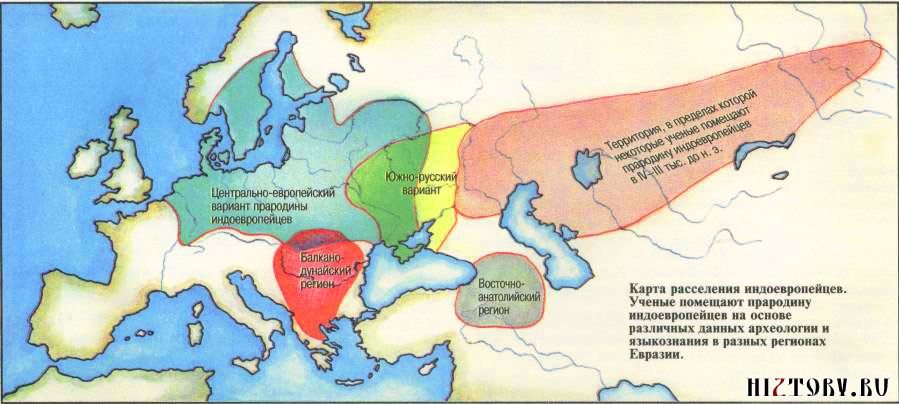
In the myths and tales of the peoples of India, memories of their ancient northern ancestral home have been preserved, while in the north of Russia the names of rivers and lakes still exist, dating back to Sanskrit, the ancient language of India.
During the resettlement of the 4th - 3rd millennium BC. NS. The Indo-European community, which occupied vast lands from Western Europe to India (hence the name), began to disintegrate. In the conditions of constant movement, the development of new territories, the Indo-European tribes were increasingly moving away from each other.
Warlike, energetic Indo-Europeans came to where other peoples already lived. These incursions were far from peaceful. Long before the first states, armies appeared on the territory of Eurasia, wars began, our ancient ancestors fought for comfortable lands, generous fish lands, forests rich in beasts. At the site of many ancient sites, traces of fire and hot fights are discernible: skulls, bones pierced by arrows and broken with battle axes were found there.
Indo-Europeans and ancestors of other peoples. Already during the settlement of the Indo-Europeans, their interaction and mixing with other tribes began. So, in the north-east of Europe, they coexisted with the ancestors of the Ugriches (now they include many Russian peoples - Mordovians, Udmurts, Mari, Komi, as well as Hungarians, Estonians and Finns).
In Asia and Europe, Indo-Europeans encountered the ancestors of the Turks and Mongols (their descendants from the Russian peoples are the Tatars, Bashkirs, Chuvash, Kalmyks, Buryats, etc.).
The ancestors of the Ural peoples were located in the region of the Northern Urals. Ancient Altaians were formed in Southern Siberia.
Stormy processes took place in the Caucasus, where a population was formed that spoke Caucasian languages (the ancient inhabitants of Dagestan, Adygea, Abkhazia).
Settled in the forest zone Indo-Europeans Together with other local inhabitants, they mastered cattle breeding and agriculture of the forest type, they continued to develop hunting and fishing. The local population, who lived in the harsh conditions of the forest and forest-steppe, lagged behind the peoples of the Mediterranean, southern Europe, Western Asia, and Egypt, which were gaining rapid rates of development. Nature at that time was the main regulator of human development, but it was not in favor of the north.





